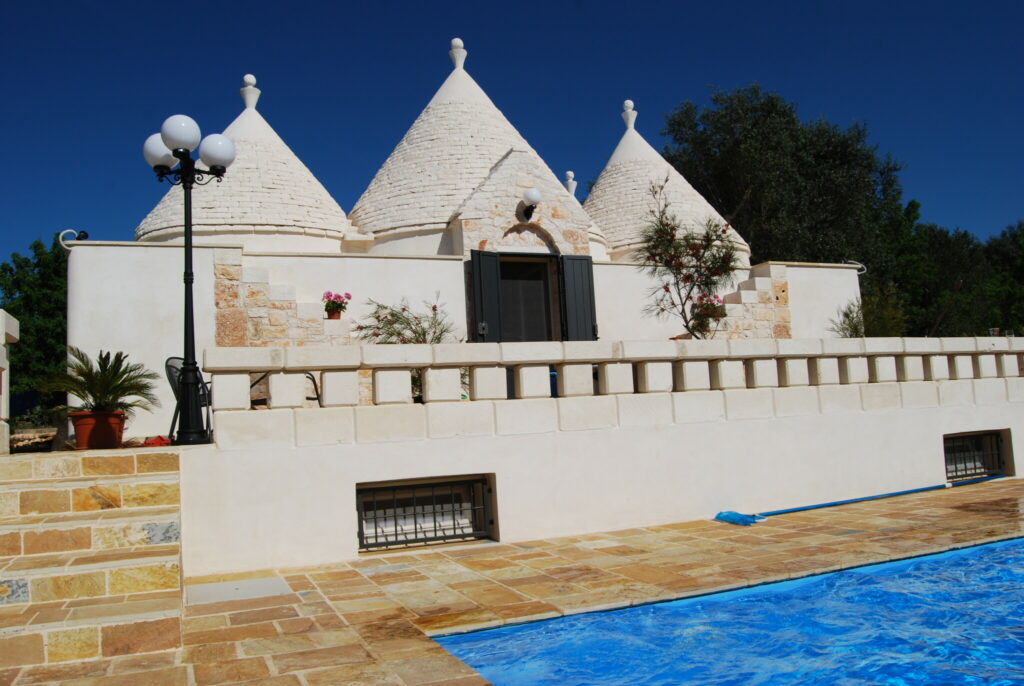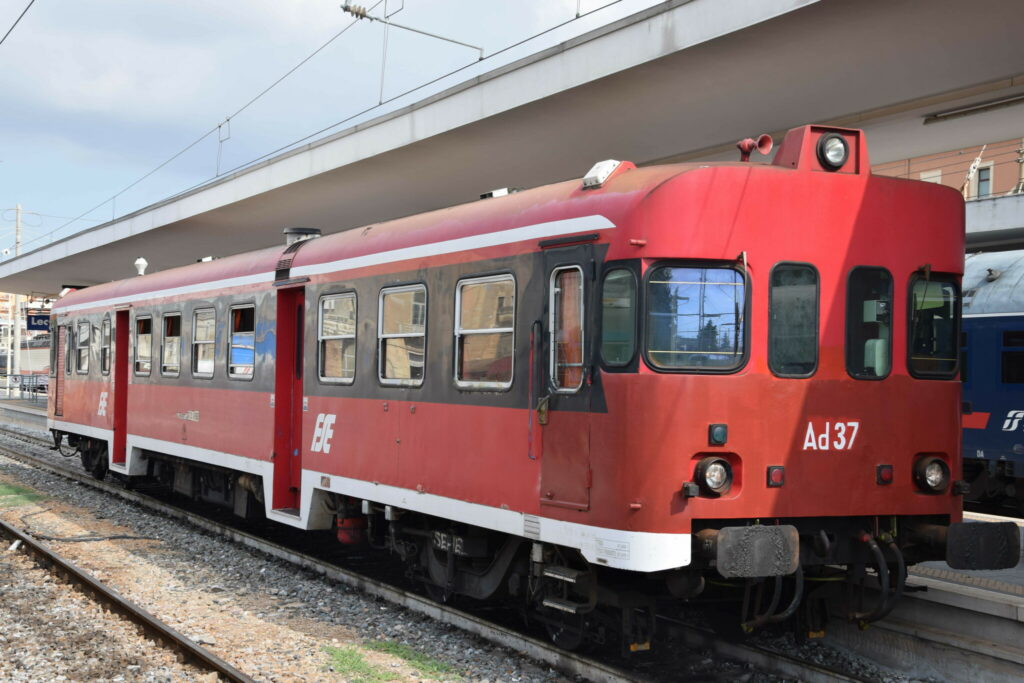
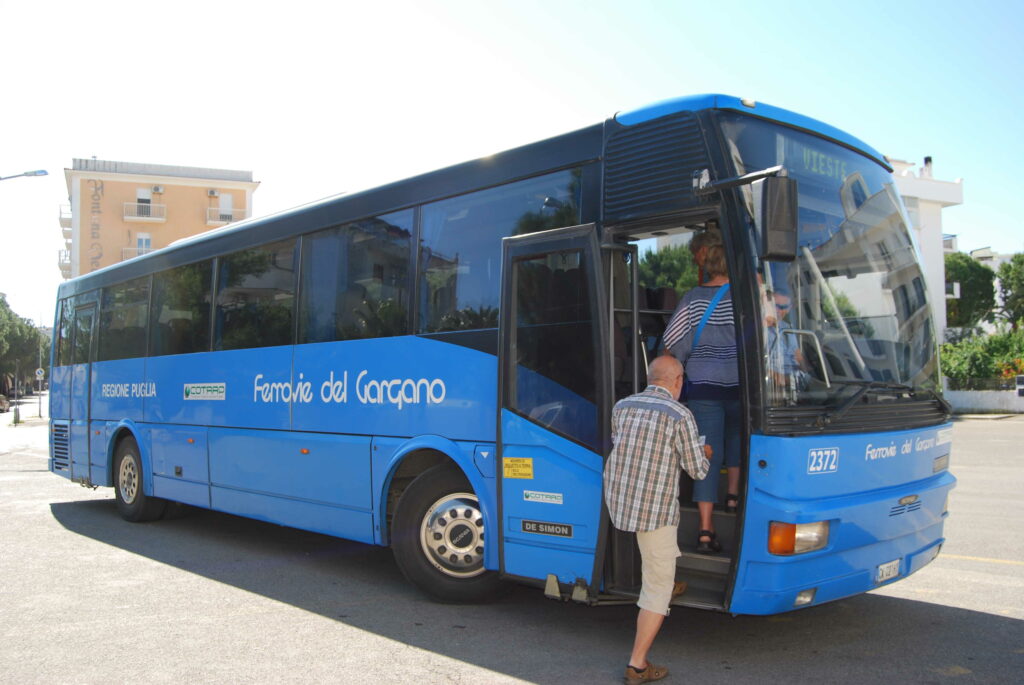
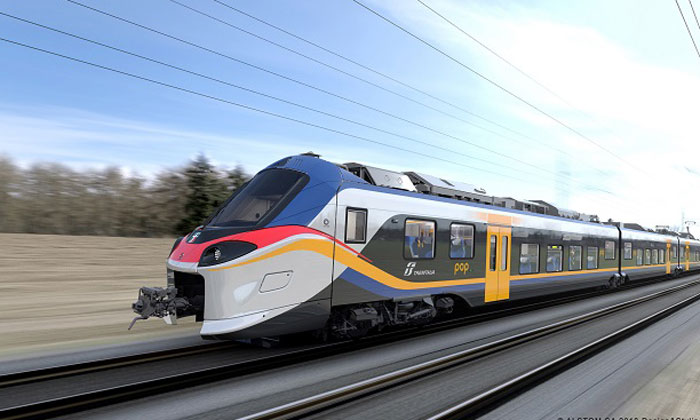
This website page deals with getting around Puglia without a car once you have arrived. IF YOU NEED TO KNOW HOW TO REACH PUGLIA IN THE FIRST PLACE, INCLUDING HOW TO REACH PUGLIA BY PUBLIC TRANS-PORT, CLICK HERE to take you to another part of the website which gives this information.
Most of the tourist advice about Puglia suggests that it is necessary to hire a car for moving around the Region. This may suit many people, but not all. It is possible, cheap and interesting to travel around Puglia using the extensive local public transport systems, especially the local railways.
In this part of the Puglia Passion website, we give very detailed information about how to use the local transport systems - how to get information, get tickets, use the trains and buses, avoid problems. This is based on extensive personal experience. The information is arranged as follows (NB you can scroll down, or you can jump to the relevant sections by clicking on the links):
- GENERAL TIPS AND ADVICE - some general points and basic advice (it is worth looking at this first)
- HOW TO REACH KEY PLACES NOT SERVED BY THE NATIONAL RAIL SYSTEM - specific notes on how to reach some of the places of interest to visitors which are not served by the the main state railway system - these guide you to the detailed information of most relevance to the place you want to visit
- GETTING AROUND PUGLIA BY LOCAL RAILWAY NETWORKS - full details about the Puglian elements of the Italian state railways (FS/Trenitalia) network; and of the local railways operated by four companies separate from the main state system (these extensive local railways are an interesting and useful feature of travel in Puglia)
- GETTING AROUND PUGLIA BY BUS AND COACH - including significant bus services operated (slightly confusingly) by the railway companies and advice on how to use the slightly awkward website of COTRAP, a consortium of bus operators in Puglia.
Elsewhere on the website, in the information we provide about specific towns and places of interest, wherever possible we offer advice about arriving by public transport, especially when arriving at a railway station.
Inevitably things change. We do our best to keep the site updated, but we cannot guarantee total accuracy. We encourage people to get in touch with us if they have useful information or experience to report to help us keep abreast of changes.
Details about how to get reach Puglia from elsewhere in Italy and Europe by air, car, train and coach are set out elsewhere on the website – click here.
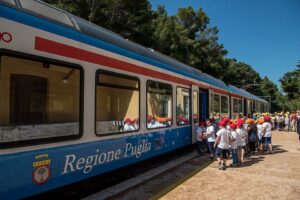
***
GENERAL ADVICE AND TIPS
The Puglia Region has a very extensive public transport system which goes way beyond the places served by the main state railway system (FS/Trenitalia). Cheap local train and bus services reach even quite remote places everywhere. Here we give some suggestions to assist in using the systems effectively and easily.
Railways
As well as the main national railways (FS/Trenitalia), there are four separately managed Puglia based regional rail companies
- Ferrovie del Gargano (FdG)
- Ferrovie del Nord Barese/Ferrotramviaria (FNB)
- Ferrovie Appulo Lucane (FAL)
- Ferrovie del Sud Est (FSE).
Between them these railway operators provide a dense network not normally shown on maps of the rail network in Italy and not usually bookable via the FS/Trenitalia online systems. (Although there is a gradual integration of the Ferrovie del Sud Est network into the FS/Trenitalia national system since a “takeover” by the latter in 2016).
To jump to the section giving full details and advice about all the Puglia railway services, click here.
Local bus services
Somewhat confusingly, all these Puglian railway companies also run significant interurban bus networks as well as trains; even on the train services “rail replacement coaches” are quite common and pretty well universal on Sundays. Bus services run by the Ferrovie del Gargano and even more so by Ferrovie del Sud Est are especially significant for visitors.
Additionally, other interurban bus services are run by various companies, some publicly owned, some privately operated. The most important of these are Sitasud, ACAPT, STP Brindisi, STP di Terra d’Otranto (which also operates summer services under the name "Salento in Bus"). .
To reach the section giving full details and advice about bus services run by all the relevant agencies, click here.
COTRAP
Many of the bus and coach operators are linked into a federation known as COTRAP (Consortium Trasporto Pugliese). This has a website which allows timetables enquiries and bookings throughout Puglia.
While this is a great idea in principle, unfortunately the website enquiry system has a number of quirks. Also there are important networks (in particular buses run by the FSE railway company) which are not part of COTRAP, and so no information is provided about the travel options offered by this and other non-members. This is a severe limitation which may change at some time time.
It is probably impossible to avoid using the COTRAP website sometimes. Several of the COTRAP affiliated companies automatically refer booking and timetable enquiries on their own websites straight through to the COTRAP website. We therefore include in our information instructions about using the COTRAP search system when searching for bus routes - you can access this advice via the section on using local buses - click here - and then scrolling down/jumping to the information on COTRAP.
Tips and warnings
Familiarity with how things operate is needed to take advantage of what is available. We give a lot of detail here on our website; but a few general points to note are:
- many pubic transport options, especially bus services, are not especially geared to tourism; services for work, shopping and school take priority
- on all timetables, it is vital to check the small print about services – those operating on weekdays (feriali) and Sundays/official holidays (festivi); any which only run on schooldays (scolastici); any which only run on specific days; etc
- when using trains, it is very important to validate your ticket before boarding by putting it into one of the machines in the station or on the platform (or in some cases presenting a bar code); validation on buses is also often needed using a machine on board the bus, even if you buy the ticket from the driver
- train stations are often outside town centres, and sometimes well outside, so check up on this before going somewhere by train; be prepared to walk up to a kilometre from a station to the centre, and in a few cases be ready to use a bus fom the station if there is one, or use a taxi
- services are generally reliable, but a degree of patience and occasional optimism is vital - be prepared to deal with late running, a missed connection, occasional cancellation, unclear bus stops etc; ideally regard the travel process as an interesting experience in itself! - reduce any stress by not having deadlines for arrival
- while bus stops and railway stations are often conveniently located next to one another, this is not always the case, also the bus stops used by different agencies are quite often in different places; if your trip involves a change of buses or between train and bus, make sure you know where the relevant bus stops are
A specific warning about the route and timetable options given on the Trenitalia/FS and Ferrovarie del Sud Est websites
The FSE runs bus services as well as train services. Its website for searching route and timetable options is now integrated with the national Trenitalia/FS system. This has made searching for timetable and route information in Puglia quite difficult, as it covers bus options as well as train options, even though the FSE bus services and train services operate quite separately from one another. Details of the problems and how to handle them are set out on the sections dealing with train services (click here) and bus services (click here).
Buying tickets
Tickets can often be bought on board buses and trains, but not always, and sometimes there may be an extra charge. We advise getting tickets before boarding if possible.
Tickets can be bought online in many cases using a credit card to pay. This facility is offered on the websites run by Trenitalia (covering both Trenitalia/FS trains and FSE trains and buses); by the FSE and other train company websites covering their own train and bus services; and by the COTRAP website covering most other services. The booking process is straightforward (even on the COTRAP website) once you have decided on your trip details. Tickets can be downloaded to a phone or computer and displayed as required; or printed off.
If you cannot do this or don't want to (you may want to stay flexible as you move around), you can usually buy tickets "on the day" easily (we normally do this) using
- staffed ticket offices during daytime and early evening at the larger FS stations (these sell only Trenitalia/FS tickets and increasingly they also sell FSE train and bus tickets); but note most stations are now unstaffed, so assume there is no station ticket office anywhere except Foggia, Barletta, Bari, Brindisi, Lecce and Taranto
- ticket machines, which are present on virtually every station, even the smallest, on all the rail networks; we find these the best option to buy train tickets, and use them even when stations are staffed (we provide a few notes below on how to use ticket machines)
- from bars, licensed tobacconists (the big "T" sign") and newsagents which act as ticket agencies - at least one of these can usually be found on or near railway stations or bus stops, they display signs for the organisations whose ticket they handle (although if you don't spot a sign it is worth going in somewhere and asking); however, it is not unknown for these ticket outlets to be located some distance away from remote bus stops and small isolated stations on the regional networks, so if you are going somewhere remote it makes sense to buy a return ticket when you have the opportunity (NB lists of ticket sales outlets are shown on most of the various company websites, which can help).
- bars, tobacconists and newsagents are usually the best and often the only place to buy bus tickets; although there are proper sales counters at bus terminals in the largest towns.
Ticket machines on stations are easy to use and give instructions in a choice of languages (on FS stations these are shouted at you rather loudly!). Some machines do take cash but using a credit or debit card is much easier. The following instructions relate to the FS station machines, but those on the regional line stations operate in much the same way:
- Get your credit card ready
- Touch the flag to get a service in English or another language if you want, Italian is the default; and wait a few moments.
- Touch to buy tickets
- Touch on the destination if it is displayed as an option, or touch for other stations - then touch on the letters on a keyboard until your destination is displayed; then confirm
- The next few trains will be displayed with their times and prices - on FS lines this will include the more expensive Freccia and Intercity trains, so be careful to select the right category; touch the train you want (NB you will be warned if the selected train is subject to any delay, which is useful)
- A screen comes up asking for how many adults and how many children; touch the + sign to increase the number shown - just touch it once and wait for the figure to change, this often takes a few seconds; then confirm
- Your order is confirmed (sometimes you get a warning that there are some restrictions on ticket use, a warning that the train is late etc, just touch on OK to these) and then you are asked if you are paying by credit card - confirm (there is sometimes no cash option anyway) and look at the little screen on the credit card extension on the right hand side of the main machine
- Wait for an instruction on the screen to insert your card; enter the pin in the usual way, then extract your card - the machine will be shouting at you throughout this process
- Alternatively, increasing numbers of machines have a contactless option on the main machine front, so you can just present your card there; if you do this wait several moments while everything seems to freeze, you can check that things are happening by looking at the small screen on the credit card extension which will say that the transcation is in progress - if contactless is not working you will need to insert the card as described above
- Wait fir your tickets to be printed and pick them up your tickets.
If the sequence does not work out, it is worth starting again once, or using a different machine. But if you don't succeed twice, find somewhere to buy tickets or pay on the train.
Rome to Rio website
If you have a specific trip in mind, one very useful starting point is the Rome to Rio website. This is straightforward to use, simply enter your departure and destination locations (which can be very precise). The website generates various options for travel including train and bus options with details, including times and operators.
In our experience the website does help but only as a starting point. It is necessary to follow up on any timetable, route and operator details it indicates, we have several times found its own information to be inadequate. And sometimes it has not suggested options which are actually available, so if you draw a blank on Rome to Rio, don't give up.
So whether or not this website does come up with something, we still suggest using our website to follow up; additionally of course we give much more specific information to make your trip easier. If you are looking to get a more general feel for what is available, before you have specific trip in mind, then our website will be a more useful starting point than the Rome to Rio website.
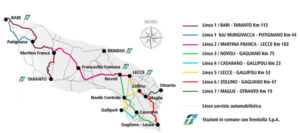
***
HOW TO REACH KEY PLACES BEYOND THE NATIONAL RAIL NETWORK
Many of the key cities, towns and other places in Puglia can be reached using the main FS national railway system. We list these and provide further information in the section on getting around by train.
However, to reach other places you will need to rely on the local train and bus networks. Specific information and advice on how to reach some of these places is given below. This information tells you which sections of the website you should consult for help with that specific journey. You should also always look at the section on general tips and advice.
To provide addional help, in descriptions of the individual places covered in our website, we also give information on arriving by public transports; so if you are thinking of visiting a town, it is worth looking at our descriptions (links are provided).
We assume that visitors will be able to reach key "jumping off" places easily using FS/Trenitalia - these are listed below. These are all railway stations on the main national network. We give a few details of key bus and other train termini in relation to the main stations, especially where these are not immediately next to the railway station.
Please note - there are masses of local bus services operating in even quite small towns in Puglia, serving very local areas and geared to local needs eg schools, industrial estates, shopping centres, hospitals etc. We only refer to these services in a few special cases.
Places which can be reached using the national FS/Trenitalia system
The following places are all accessible using the national FS/Trenitalia rail system.
Fasano/Cisternino (NB there is a main line station called Cisternino, but this is a long way from the town itself - if you want to reach Cisternino from the main FS line, it is better to use Fasano station, from where there is a STP Brindisi bus service - see this link to reach a PDF of the timetable -connecting Fasano station with both Fasano city centre and Cisternino; alternatively Cisternino has a much more convenienet Ferroviue del Sud Est railway station)
Ostuni (there is a STP Brindisi bus service connecting Ostuni railway station to the city centre; this connects with many trains from early morning until late at night - this link leads to a PDF giving timetables for this service.
Information on the main "jumping off points" served by FS/Trenitalia
The hubs are where you are most likely to need to change from the national train service to the local trains and buses. They are all important visitor destination in thesmselves, so links are given to the parts of our website which describe them in detail. The information here focuses on the connections between transport services.
The Ferrovie del Gargano trains operate from the main FS railway station in San Severo.
Sita Sud, ACPT and Ferrovie del Gargano bus services all have stops close together just opposite the main station entrance - on COTRAP these stops are named Viale Matteoti
The Ferrovie del Gargano trains operate from the main FS station in Foggia.
Sita Sud, ACPT and Ferrovie del Gargano bus services all have stops immediately outside the main station entrance - on COTRAP these stops are named Piazza Vittorio Veneto and Nodo Intermodale.
The main entrance to Bari Centrale FS station is on Piazza Moro; there is a secondary entrance on the oppsite side of the station, Via Capruzzi.
The Ferrovie del Sud Est (FSE) trains use the main station, from platforms at the side of the station opposite Piazza Moro, reached via subways, or from the Via Capruzzi entrance. You can get tickets at some outlets on the main station concourse and also a small ticket office on one of the FSE platforms.
The Ferrotramviaria/Ferrovie del Nord Barese (FNB) trains, including the airport link, operate from a dedicated FNB station on the north side of Piazza Moro (left hand side as you leave the main station); there is a booking office at the station entrance.
The Ferrivie Appulo Lucane (FAL) trains operate from a dedicated FAL station on the north side of Piazza Moro next door to the FNB station. It has a booking office at the station entrance.
FSE, Sita Sud and Borman bus services have stops just outside the Bari Centrale station entrance on Via Capruzzi; this is the opposite side of the main station from Piazza Moro. If you are using FSE bus services in particular, remember this, they do not operate from Piazza Moro.
OSTUNI (this is where Puglia Passion is based).
The FS railway station in Ostuni is served by all Regional trains, most Intercity trains and some Freccia trains (especially in summer).
The railways station is some distance from the city. However, there is a fairly frequent STP Brindisi bus service linking the station and the centro storico and also the commercial centre of Ostuni. The two main interurban bus stops in Ostuni are both served by this bus connection with the FS station; they themselves are a short distance apart (Piazza Italia and Viale dello Sport).
The Ferrovie del Sud Est (FSE) bus services operate from Viale dello Sport in the commercial centre of Ostuni. On the FSE website this is called Ostuni (Bus). Tickets can be purchased in a a nearby bar - Cafe Noir.
The STP Brindisi interurban buses have main stops on either side of Piazza Italia, which is at one end of Viale Pola in the commercial centre of Ostuni, also served by the station bus service. Tickets can be purchased in various bars etc in Ostuni.
The bus stop for the STP Brindisi bus connection with Brindisi airport is immediately outside the main station entrance.
Interurban STP Brindisi bus stops near Brindisi station are a few metres to the left as you emerge from the main station entrance along two parallel streets - Bastione Carlo V and Via Independenza
The Ferrovie del Sud Est trains operate from platforms on Lecce main station at the side opposite the main entrance; accessed via a subway. Tickets can be bought on bars etc in the station concourse.
Connection from the railway station to bus services operating out of Lecce is more problematical. Bus stops and the main bus termninals are some distance from the railway station. So if you are planning a bus trip from Lecce, use the COTRAP website to locate a bus stop for the trip you are planning.
There are some bus stops not far from the railway station, but you will need to know exactly which one to head for to get the bus service you require. The most useful of these stops is a STP Terra d'Otranto stop on Viale Marche, about ten minutes walk from the station (head straight ahead from the station entrance along Viale Oronzo Quarta, turn right at the traffic lights along Viale Gallipoli, the stops is just beyond a roundabout, near the Questura). But there are other stops not too far from the station used by different services.
The central bus terminal in Lecce (usually called City Terminal) is a low key facility some distance away from Lecce railway station, at the Foario Boario. This is actually a collection of bus stops, and some of these use different names for their stops - for instance "Hotel Tiziano". However, by using the COTRAP map you will be able to spot stops in or near the Foario Boario. (Although it has a bus stop at the City Terminal, STP Terra d'Otranto services have a main terminal of their own, a short distance away on Via Carluccio).
It is a 25-30 minutes walk between the main railway station and the City Terminal. However there is a local bus service (M1) which runs between them two every few minutes - a ticket can be purchased before boarding at lots of outlets, the (rather circuitous) trip takes about 10 minutes. The City Terminal is next to a large car park, where car-borne visitors are expected to arrive and travel into the centre by local bus. It is also the place where the coach connection between Lecce and Brindisi airport arrives/departs.
Depending on where you are going of course, it is possible to avoid changing between rail and bus at Lecce by changing onto the FSE rail services from Lecce station and picking up a bus connection more conveniently at Maglie.
The Ferrovie del Sud Est (FSE) trains use the main FS station in Taranto.
Sita Sud, STP di Terra d'Otranto and other bus services have stops in Porto Mercantile. This is a five minute walk from the railway station (go straight ahead from the station entrance, stick to the main roads through two roundabouts, the road signs will point towards Massafra). There are several bus stops there, find the one you want.
++++++++++++++++++++++++++++++++++++++++++++++++++++++++++++++++++++++++++++++
Reaching places in the Foggia area and the Gargano peninsula
We suggest going to San Severo or Foggia by train and then using the Ferrovie del Gargano train service to Peschici (Calenella); there are then bus connections the short distance to Peschici itself (the bus terminal is just above the old town). The train follows an attractive route along the marine lakes and beaches of the Gargano north coast. Go to our website page on rail networks and scroll down/jump to the section on Ferrovie del Gargano.
There are also bus services from San Severo (Ferrovie del Gargano buses) if the few trains a day are inconvenient - go to see details of bus services operated by Ferrovie del Gargano.
Taking a bus from Foggia (Sita Sud) is the best option. There are quite frequent buses during the day, with direct and more circuitous options available. (NB The FS line between Foggia and Manfredonia operates rather erratically, so best avoided).
For details go to the section dealing with Sita Sud bus services.
You can take the train service to Peschici described above and then go on by bus (FdG buses).
Or you can go by bus from Foggia via Manfredonia and the south coast of the Gargano (Sita Sud buses). For details go to the sections dealing with bus services operated by Ferrovie del Gargano and bus services operated by Sita Sud. .
San Giovanni Rotondo, Monte Sant'Angelo
These popular destinations can be reached by buses from San Severo and from Foggia (FdG buses). For details go to the page dealing with bus services operated by Ferrovie del Gargano.
This small city has an attractive small historic centre, a massive ruined castle and a Roman amphitheatre. It is about the easiest "off the beaten track" town to reach in Puglia - 20 minutes by a frequent Ferrovie del Gargano direct train service from Foggia. For further information go to the section dealing with FdG rail services.
This small village in the hills south west of Foggia is offically listed as one of Italy's most attractive villages. It is served mainly by a reasonably frequent bus service operated by ACAPT from Foggia. For details go to the section dealing with bus services operated by ACAPT.
Reaching places north and west of Bari
These and other places inland north of Bari are best reached using the Ferrotramviaria/Ferrovie del Nord Barese from Bari Centrale (FNB) station which is next to Bari Centrale main station; or in the other direction from Barletta station. Details are on the section dealing with FNB rail services.
This important World Heritage Site is in the countryside and most people go there by car. However, there is a shuttle bus service from Andria operated by Andria City Council municipal bus services; this runs daily in summer, Sundays and public holidays only between February and March. Timetable details here.
To visit these places west of Bari use the Ferrovie Appulo Lucane trains from Bari Centrale (FAL) station next to Bari Centrale main station. For details go to the section dealing with FAL rail services.
For Matera, it may be convenient to get the Freccilink caoch service from Bari Centrale, if this service is resumed - if it is re-established it is likely to be only in the summer.See details of the Freccialink coach service here.
Reaching places in the area south of Bari
FSE train services connect Bari Centrale and Putignano. The trip takes about an hour.
Currently (Summer 2023) trains do not seem to be serving Conversano. If you look up connections on the FSE or Trenitalia websites, you will be shown mainly FSE bus connections (in particular the Grotte link). This takes about an hour, but is a pretty miserable trip. We suggest looking at options involving a train to Putignano followed by a shorter bus connection between Putignano and Conversano.
Public transport to this major tourist attraction is abysmal.
There are two stations on the FSE, one for the famous caves and one for the town; but currently (Summer 2023) train services do not seem to be calling at these. It is necessary to use an FSE bus service which stops at the entrance to the caves. Consult the FSE/Trenitalia for connections from Bari, which will generate a list of options involving FSE trains and buses. For details of this, see the section dealing with FSE train services. The most obvious and simplest option is to take an FSE bus from Bari Centrale (note that the FSE buses leave from the far side of the station, not from Piazza Moro) labelled Grotte Link. Despite this encouraging title, the bus journey is pretty miserable and takes an hour and a quarter each way, passing through various places on the way including Rutigliano and Conversano (you may want to break the trip at one of these towns). The bus stop at the caves is very convenient, five minutes from the main entrance (be careful to stay on the bus beyond the town of Castellana Grotte). The bus does not terminate at the caves - it goes on to Putignano.
If you want to avoid this rather unpleasant bus trip, see if you can find an option involving an FSE train to Putignano followed by a short hop on the bus (the Grotte Link on a return journey to Bari) to the caves. It takes about as long altogether but is a pleasanter experience.
Reaching places in the Itria valley - "trullo country"
Noci, Martina Franca, Alberobello, Locorotondo
This group of wonderful towns, including the World Heritage “trullo town” of Alberobello, are perched on the low hills overlooking the Itria valley with its network of trulli, vineyards and olive groves. If you are travelling from Bari, all these places are served by the FSE railway line which meanders through this beautiful countryside between Bari Centrale and Martina Franca. (You may sometimes have to change at Putignano for Noci and Alberobello). However, for Alberobello, an alternative option is a bus service from Bari described as the Trulli Link. This is also run by FSE (so it shows up on the Trenitalia/FSE website if you enter Bari - all stations) leaving from Bari Largo Sorrentino, which is among the FSE bus stops at the far side of Bari Centrale station opposite the main entrance. This trip takes just over an hour; it is a straightforward option, although we personally prefer the train.
The FSE also operates a line from Lecce to Martina Franca, so if you are based in Lecce, use this line and change at Martina Franca to travel to the other places. (So far as we know, there are no trains running through from Lecce all the way to Bari, but the timetables are coordinated to facilitate the change of train at Martina Franca station). For details go to the section dealing with FSE rail services.
If you are based in Ostuni, there are a very few bus services to Martina Franca and other places in the Itria valley, and the ones which exist are at inconvenient times. We therefore recommend getting an FSE bus from Viale della Sport to Ceglie Messapica (see below), which are reasonably frequent. This trip takes only about 15 minutes. Get the bus driver to stop as it passes the level crossing near Ceglie FSE railway station. Then walk round to Ceglie Messapica station and catch an FSE train to Martina Franca, which goes through Cisternino; you can change at Martina Franca onto another FSE train which goes through the other places mentioned en route to Bari Centrale. It is worth looking at the advice on our web pages dealing with bus/coach services and on rail services operated by the FSE - for FSE bus services click here and for FSE rail services click here..
An alternative from Ostuni is to get an STP Brindisi bus from Ostuni (Piazza Italia) to Cisternino - see below, then travelling on to Martina Franca on the FSE. For details of the bus leg of this option see our information on STP Brindisi.
This is another gem overlooking the Itria valley. You are advised to use the FSE train service between Martina Franca and Lecce. If travelling from Bari, you will need to take the FSE train and change at Martina Franca. If travelling from Lecce take the FSE train heading from Lecce to Martina Franca. See our information on FSE rail services here.
It is best to avoid Cisternino station on the main FS line between Bari and Brindisi; it is nowhere near the town itself and there are no convenient bus connections. However, if you prefer to use the main line rather than the FSE, there is an option of using Fasano station and taking a bus to Cisternino from there - this link takes you to a link with a PDF of the timetable for this service.
From Ostuni, there is a reasonably frequent STP Brindisi bus service to Cisternino from the stop in Piazza Italia opposite Carrefour. For information on this service click here.
If you are based in Brindisi, use the FS/Trenitalia service from Brindisi to Francavilla Fontana; there you can change to an FSE train at the same station. Or you may prefer to go on the main line to Fasano and pick up the local STP Brindisi bus service there, as described above.
Reaching places between Between Brindisi and Ostuni
Ostuni
For travel between Bari, Ostuni and Brindisi use the FS/Trenitalia line. Useful details here. Ostuni station is about 2 km from the centre, but there is a good STP Brindisi bus connection between the station and the centre of Ostuni - the timetable for this service is available on a PDF via this link.
This small town is famous for its historic centre and its restaurants - one of Puglia's culinary high spots.
From Lecce, take the Ferrovie del Sud Est train to Ceglie (possibly changing en route at Novoli). Details on the FSE train services here. From Brindisi, go to Franacavilla Fontana on the FS/Trenitalia line (heading to Taranto) and pick up the FSE train there (same station).
From Ostuni, get an FSE bus from Viale dello Sport (stop outside the school), which is the FSE bus terminus in Ostuni - on the websites it is called Ostuni(bus). It takes about 15 minutes direct, the bus terminus in Ceglie is near the hospital, just outside the historic centre (it is not next to Ceglie FSE railway station, which is about 10 minutes walk from the bus terminus; although you can ask the driver to drop you off near the station if that is where you want to go). For details go to section dealing with FSE bus services.
Carovigno, San Vito dei Normanii
Both these towns have FS railway stations on the main line between Brindisi and Bari, but not many trains stop there and they are both a long way out of town (although they are both quite close to seaside resorts/beaches if that is your destination - Carovigno station is near Santa Sabina, San Vito station is near Serranova and Torre Guaceto).
We do not advise using San Vito FS station to reach the town. However, STP Brindisi do have a service connecting Carovigno station to the city centre; this connects to trains, so if you are travelling from Lecce or Bari then using Carovigno station and this bus service is an option - timetables for this service are on a PDF reached via this link.
Generally, to reach these towns, it is better is to use the fairly frequent STP Brindisi bus services from Brindisi or Ostuni, which goes through both places. For details go to our section on STP Brindisi bus services. The terminus in Brindisi is on Via Indipendenza or Via Bastione, near the front of the FS station (NB services also operate from another part of Brindisi, and do not go via the city centre). The stop in Ostuni is on Piazza Italia, at the top end of Viale Pola (near the Carrefour supermarket).
reaching places between Brindisi and Taranto
The bus service mentioned above between Ostuni and Brindisi goes through Mesagne. This is the best way from Ostuni. However, Mesagne is also served by the FS line between Brindisi and Taranto, so it can be reached most easily from those places by train.
Oria,Francavilla Fontana, Grottaglie
These three places are all served by the FS/Trenitalia line between Brindisi and Taranto. This is more convenient than various bus services.
Francavilla Fontana is also served by the FSE railway between Lecce and Martina Franca, which offers a more convenient link from Lecce. The other towns could also be reached by train from Lecce by changing at Francavilla Fontana rather than Brindisi
Manduria is served by the FSE rail service between Lecce and Martina Franca via Novoli. This is the best way of reaching Manduria from Lecce. Alternatively it can be reached by using the FS/Trenitalia line beteen Brindisi and Taranto.
Reaching places in the Salento south of Lecce
This is an area with some of the most beautiful towns and beaches in Puglia. Trips within a day from Lecce, Brindisi and Ostuni are feasible to many places.
Maglie tends to be somewhere people change trains/buses; if you get a chance, do explore the small city centre. Maglie is easily reached from Lecce on FSE trains heading towards Gagliano del Capo (make sure you are not on a Gallipoli train). Details of FSE train services here. There are also bus services between Maglie and Lecce.
Gallipoli, on the Ionian coast, is one of Puglia's most popular visitor destinations. It is easy to reach from Lecce using frequent direct FSE trains - the trip takes about 90 minutes. (Make sure you are not on a train heading for Gagliano del Capo via Maglie). Details of FSE train services here.
This famous place on the Adriatic coast can be reached best by using FSE trains from Lecce and changing at Maglie onto a shuttle service. See above how to get to Maglie. The journey is just over 90 minutes. Details of FSE train services here.
Copertino, with its enormous castle, can be reached using FSE trains from Lecce. Take a direct train heading for Gagliano del Capo via Novoli and Nardo Citta - do NOT get on a train heading for Gagliano del Capo via Zollino, Maglie and Tricase. Sometimes you may have to change at Novoli. In any case the trip takes about 45 minutes. Details of FSE train services here.
This elegant town is the home of the tarantella, Puglia's renowned dance spectacle; and the reputed birthplace of pasticiotti, Puglia's traditional pastry. It is very straightforward to reach from Lecce, using the FSE train service heading for Gallipoli (make sure you get a train heading towards Gallipoli, not Gagliano del Capo).Details of FSE train services here.
This wonderful baroque jewel can be reached using FSE trains from Lecce. It is important to get to Nardo Citta - the station called Nardo Centrale is essentially a junction where people change trains, it is some way outside Nardo itself. Take a direct train heading for Gagliano del Capo via Novoli, Nardo Citta and Casarano - do NOT get on a train heading for Gagliano del Capo via Zollino, Maglie and Tricase. Sometimes you may have to change at Novoli. In any case the trip takes about 45 minutes. Details of FSE train services here.
This interesting town, an excellent base for exploring the south of the Salento, is easy to reach from Lecce using a Ferrovie del Sud Est train heading for Gagliano del Capo via Maglie. Details of FSE train services here.
This beautiful small town is high on our list of places to visit but pretty awkward to reach by public transport.
We advise avoiding the railway station called Monsano/Miggiano/Specchia on the FSE line between Maglie and Galgiano del Capo. It is some distance (about 2km) outside Specchia via an unattractive, quite busy road; and there are no facilities at the station at all, so it may be difficult to get a taxi unless something has been arranged in advance.
A better option is to take an FSE train from Lecce heading to Gagliano del Capo via Maglie and get off at Tricase, which takes about 90 minutres with trains roughly every hour. See above how to reach Tricase, which is a substantial town with facilities at the station and nearby; it is possible to get a taxi for the short trip to Specchia (about 15 euros at most). There are a few bus services between Tricase and Specchia but they are at inconvenient times.
Alternatively, there are STP di Terra d'Otranto direct bus services between Lecce and Specchia; this service can be picked up if preferred at the stop in Maglie which is near the FSE station (the bus terminus in Lecce is some distance from the station). See above how to reqach Maglie. See our information on STP di Terra d'Otranto bus services here.
Casarano is easily reached from Lecce using an FSE train. There are direct services which take about 90 minutes headed for Gagliano del Capo via Nardo Centrale; and services which involve changes at Novoli and/or Gallipoli (these latter take about 2 hours). There are trains roughly every hour. Details of FSE train services here.
During the mid June-mid September period, an alternative option is to take the Salento in Bus service between Maglie and Gallipoli, which does quite a significant detour to pass through Casarano. See above for travelling between Lecce and Maglie. Details of the Salento in Bus services are available here.
Ugento is a significant toiwn and destination, yet It is surprisingly awkward to reach by public transport. Bus connections with Lecce and even Gallipoli are limited and awkward. The FSE railway station is not close to the town centre.
The FSE trains from Gallipoli heading for Gagliano del Capo (and also those from Lecce heading for Gagliano del Capo via Nardo Centrale and Galatone) call at a station called Ugento-Taurisano. There are trains roughly every 90 minutes and the trip takes about 90 minutes. Details of FSE train services here. However, the the station is some distance from Ugento itself and is hardly convenient. Although there are bus services between the station and the town centre, details are tricky to find; and quite a few services seem to be just on schooldays.
We therefore advise that if you use this station you need to be prepared to walk or get a taxi in the absence of a convenient bus when you get there (the same applies if your are returning from Ugento viua this station).
The best means of reaching Ugento does seem to be by going to Casarano first using the FSE train services (see above) and getting a bus from Casarano. Combining visits to these two places may make sense anyway. The bus trip between the two takes 30-45 minutes. There are FSE bus services and Sita Sud bus services. These two agencies seem to have split the route between them taking a half day each, so there are services in both the morning and afternoon. The Casarano bus stops are not all next to the station however. Fortunately this is where the map of bus stops which is available on the COTRAP website comes in handy. For details of the Sita Sud bus services, check out the details we give about Sita Sud timetables here, and look up the timetable details for the service linking Casarano (Bus) with Ugento and Torre San Giovanni (the coastal resort associated with Ugento) - there is a PDF of this available on the list of timetables under the Bari section of the Sita Sud website. For details of the FSE bus service, go to the information we provide about FSE bus services by clicking here and search for Casarano/Ugento links on their system.
Santa Cesarea Terme
This popular resort is easy enough to reach in the mid June - mid September period using the Salento in Bus service between Otranto and Santa Maria di Leuca, which runs along this southern section of Puglia's Adriatic coastline. Details of the Salento in Bus services are available here.
Outside this period it is more awkward. The best options involve travelling by FSE trains from Lecce and then changing to FSE buses at Maglie or Poggiardo - there are local buses which connect the train station to the bus staion in both places. Details of FSE train services are here. Timetable enquiries give options for a combination of trains and buses. You may want to get details of the FSE bus services by clicking here.
Andrano, Marina d'Andrano
Andrano is reached best from Lecce using an FSE train service to Andrano-Castiglione (use an FSE train heading for Gagliano del Capo via Zollino and Tricase). At Andrano-Castiglione station you can get a local bus connection to Castiglione and then an FSE bus from there to Andrano.Details of FSE train services are here. Timetable enquiries give options for a combination of trains and buses. You may want to get details of the FSE bus services by clicking here.
The coastal resort Marina di Andrano is easy enough to reach in the mid June - mid September period using the Salento in Bus service between Otranto and Santa Maria di Leuca, which runs along this southern section of Puglia's Adriatic coastline. Details of the Salento in Bus services are available here.
Outside this period, we are not aware of any reliable public transport options, and suggest going to Andrano (see above) and taking a taxi from there.
This is the tip of the "heel" of Italy, so it is something of an ambition to reach the spot and look out over the sea from the lighthouse there. Santa Maria di Leuca is also an elegant resort, well worth visiting.
It is possible to travel by FSE train direct from Lecce to Gagliano del Capo, where the station is designated as serving Leuca. If you do this, make sure you get a train from Lecce going via Zollino, Maglie and Tricase, not the much longer route via Nardo Centrale and Galatone. Details of FSE train services are here.
However, the Gagliano del Capo/Leuca station is located about two kilometres outside Gagliano del Capo, and is about 10 kilometres from Santa Maria di Leuca. Bus connections between the station and Santa Maria di Leuca are almost non-existent. If you get to the station by 9.00am there is a direct STP di Terra d'Otranto service which takes 20 minutes. We have not been able to find a bus back to the station itself, and have in the past resorted to a taxi (cost 20 euros).
It is possible to walk into the centre of Gagliano del Capo where there are a few more bus services - the walk is easy and pleasant enough in fine weather, but bad news if it is hot or raining. Going the other way, there are a few STP di Terra d'Otranto services from Santa Maria di Leuca to Gagliano del Capo, after which you will need to walk to the station if you are using the FSE trains. Details of the STP di Terra d'Otranto bus services here.
Things are much easier in the mid June - mid September period when there are Salento in Bus services running between Lecce and Santa Maria di Leuca which stop at the cross roads on the main road about 10 minutes walk from the station - the stop is called Via 2 Giugno/Ospedale, there is a bar there where you can wait if necessary. Details of the Salento in Bus services can be seen here.
Generally, because of the awkward connections to and from the FSE station at Gagliano del Capo, we recommend getting to Santa Maria di Leuca by bus.
In the mid June - mid September period, we suggest using the Salento in Bus options from Lecce, Maglie, Tricase, Gallipoli or Otranto. These provide a selection of routes, so you can travel there by one route and return by another - feasible within a day from any of the places mentioned. The central route takes about two hours. All routes have intermediate stops in larger towns/resorts. See our information on Salento in Bus services here.
When the Salento in Bus services are not operating (ie between mid September and mid June), the best option is to travel from/to Lecce using STP Terra d'Otranto bus services. There are only a couple of services each way most days, but timing is such that you can spend a morning there if you want to return the ssame day. The route is central, the coastal routes are not available. The trip takes about two hours (limited or non stop). See our information on STP di Terra d'Otranto bus services here. However, if you are happy to pay for a taxi between the station and Santa Maria di Leuca, the train is an excellent experience.
Reaching places west and north of Taranto
Ginosa, Laterza, Castellaneta,Mottola
These three inland towns can be reached directly via a good Sita Sud service from Taranto. Mottola requires a change at Castellanata.
Go to the website page dealing with bus and coach travel and scroll down/jump to the section dealing with Sita Sud.
The bus leaves Taranto from the Porto Mercantile, which is a five minute walk from the railway station (go straight ahead from the station entrance, stick to the main roads through two roundabouts, the road signs will point towards Massafra). There are several bus stops there, find the one you want.
Note that the coastal marinas south west of Taranto can be reached by the FS/Trenitalia railway heading towards Metaponto.
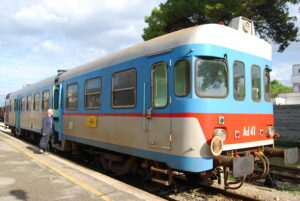
***
GETTING AROUND PUGLIA BY RAIL NETWORKS
In addition to the national railway network (Ferrovia del Stato/Trenitalia), there are four railway companies in Puglia which operate independently of the national FS railway system; although the largest of these, Ferrovie del Sud Est (FSE), is now owned by the national railway system and is to an increasing extent becoming managed as part of this. It is possible therefore to reach many parts of Puglia by rail.
All four local railway companies also run significant bus service networks as well as railways. This section of our website deals with rail services only. In all cases, it is routine for the Sunday rail services to be offered using "rail replacement" coaches - these run between railway stations, operate to a railway timetable, and are quite separate from the ordinary bus services managed by the railway companies, so you can regard these as essentially the same as rail services. All very straightforward once you know!
The national and local rail networks have benefited from significant investment and upgrading in recent years - line improvements, station modernisation, new locomotives and rolling stock. They are defintely up to the mark in terms of comfort and convenience. With the exception of the FSE, wheelchair users and passengers with bicycles can assume they can be accommodated, although it may be advisable to check in advance using telephone numbers which can be found on the company websites. In the case of the FSE, there are trains in operation where access is diffcult, so people with special needs are advised to check which type of train they will be using, again yusing telephone contacts given on the FSE website.
We give detailed information about the FS/Trenitalia network in Puglia, then of the local networks working north to south. You can jump to the relevant sections if you wish using the links below.
- Ferrovie del Stato(FS)/Trenitalia network in Puglia
- Ferrovie del Gargano (FdG)
- Ferrovie del Nord Barese/Ferrotramviaria (FNB)
- Ferrovie Apullo Lucane (FAL)
- Ferrovie del Sud Est (FSE)
***
Ferrovie del Stato (FS)/Trenitalia services in Puglia
The national railway system of Italy operates the main railway routes in Puglia as far south as Lecce.
The system is reliable and easy to use. Times and fare options can be viewed via the FS/Trenitalia website, and bookings can be made online. However, online booking is not usually necessary for journeys within Puglia, especially on Regional trains, where trains can be conveniently bought at stations. All the stations have automatic ticket machines which take credit card payments and are straightforward to use. In many places nearby newsagents, tobacconists and coffee bars have a licence to sell tickets. Only the very large stations have staffed ticket offices and there can be queues; so don’t hesitate to use the machines or other sales outlets.
The FS/Trenitalia and Ferrovie del Sud Est timetable and online booking systems have been integrated. This has benefits, but it has also caused some confusion, and users need to be aware of this. Online enquiries using the FS/Trenitalia and FSE online systems are presented with the same enquiry screen. The drop down options for departure and arrival points now give lists of all the FS and FSE stations in a town, and also all the bus stops served by the FSE, which can be numerous. It is therefore necessary to be careful about which departure and arrival point is specified whenever researching and booking online even for trips using only FS/Trenitalia services. .
For most trips within Puglia, Regional trains will be the cheapest and most convenient option. These can be fairly basic, although the rolling stock is being upgraded very rapidly, and the newer coaches are very impressive, often one of the recently acquired Pop trains.

The national system of Freccia and Intercity trains run on the key parts of the network, stopping at main stations. These trains normally have to be booked in advance. They are very spatious and comfortable; we suggest maybe using them for longer trips within Puglia eg between Barletta and Brindisi, Bari and Lecce. They are about twice as expensive as Regional trains, although online advance booking can throw up useful discounts.
The key element of the FS network consists of a main east coast spine route running through from San Severo to Lecce via Foggia/Barletta/Bari/Brindisi (the main Rome rail connection joins this at Foggia). The main stations are served by Freccia and Intercity trains. However cheap Regional trains serve all the towns on this route including Trani, Bisceglie, Giovanezza, Polignano, Monopoli, Fasano, Ostuni.
If you are spending only a short time in Puglia, it is probably best to stay in one of these places and confine your visits to other places on this main spine along the east coast. Trains are fairly frequent, at least hourly for most of the day. Tickets are obtainable at the big stations from staffed offices; card-accepting machines on all stations; or from nearby bars/newsagents. Online booking is easy enough, you can download tickets to a phone or print them off.
Other parts of the national rail system in Puglia are:
- Bari-Taranto, serving Goia del Colle and Massafra
- Brindisi-Taranto, serving Mesagne, Oria, Francavilla Fontana and Grottaglie
- from Taranto south along the Ionian coast into Calabria at Metaponto; (trains run from Taranto through Metaponto along the coast to Reggio Calabria and inland to Potenza and Naples).
The following places are all accessible using the national FS/Trenitalia rail system.
Fasano/Cisternino (NB there is a main line station called Cisternino, but this is a long way from the town itself - if you want to reach Cisternino from the main FS line, it is better to use Fasano station, from where there is a STP Brindisi bus service - see this link to reach a PDF of the timetable -connecting Fasano station with both Fasano city centre and Cisternino; alternatively Cisternino has a much more convenienet Ferroviue del Sud Est railway station)
Ostuni (there is a STP Brindisi bus service connecting Ostuni railway station to the city centre; this connects with many trains from early morning until late at night - this link leads to a PDF giving timetables for this service.
***
Ferrovie del Gargano (FdL)
The rugged Gargano peninsula had very restricted land transport links with the rest of Italy, and access to it was mainly by sea until recent times. Pressure to open it up via a railway developed during the early 20th century, to facilitate the movement of extracted minerals, agricultural products etc. The line connecting San Severo and Peschici was opened in 1931. Ownership passed through various hands until it was incorporated into its current structure, the Ferrovie del Gargano, in 1962. The company runs this line and a line linking Foggia with Lucera; as well as an extensive bus network in north Puglia and a series of national coach services connecting the Gargano with major Italian cities.
There has been considerable investment in both rolling stock and the track (including a new tunnel quite recently). The trains are modern and comfortable.
Its railways are:
Foggia – Lucera: a single line shuttle service taking about 20 minutes, allowing quick and easy access to Lucera, an interesting town with a Roman amphitheatre and the walls of a huge castle
Foggia – San Severo – Apricena – Rodi – Peschici: the Foggia/San Severo section uses the main railway line, but beyond San Severo this is the only line to penetrate the Gargano peninsula, along its northern coast; the terminus at Peschici is at Calenella, about four kilometres away from the small town itself, but there are bus connections from the station.
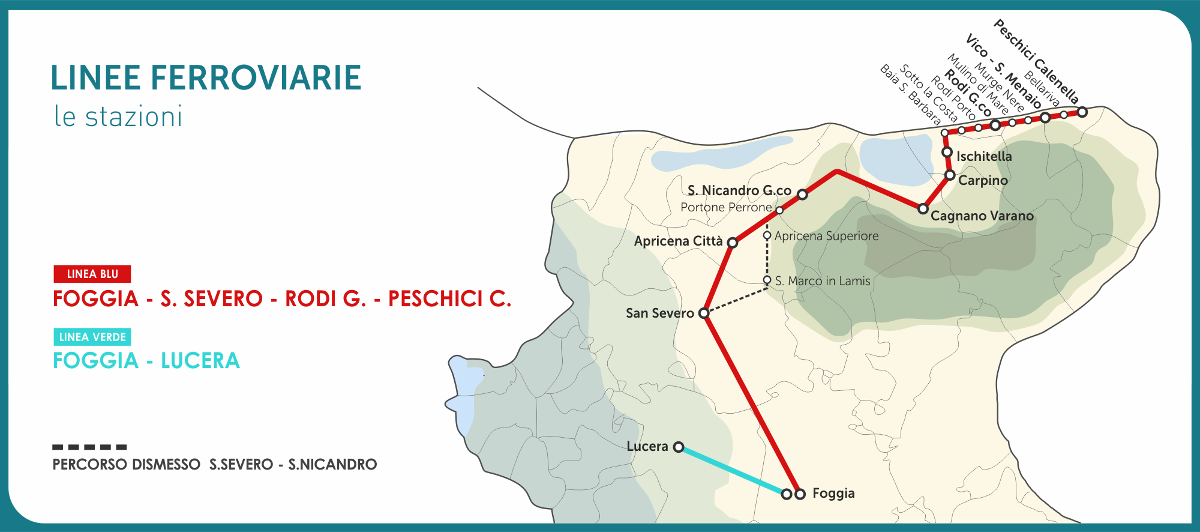
There is a general website for the FdG giving information and links, including news and updates about changes, problems etc. This site also provides a link to a pdf downloadable timetable for the Peschici line which is very useful. There are three or four services daily all the way to Peschici, more in summer. (There are more frequent services between Foggia and Apricena). If you get a chance to use this railway, don't miss the opportunity - it is a beautiful trip past the marine lakes and beaches on the north side of the Gargano peninsula. If you want to go on from Peschici to Vieste, then you can take the train then get a bus onwards from Peschici.
The Foggia - Lucera line is a 20 minute trip with services hourly or more frequently from early morning until late at night.
Tickets are available from offices, bars or machines at all the stations. If you want to see a list of ticket outlets, click here and specify the place where you need to buy a ticket. There is no need to purchase online, there is a system but it is not very robust!
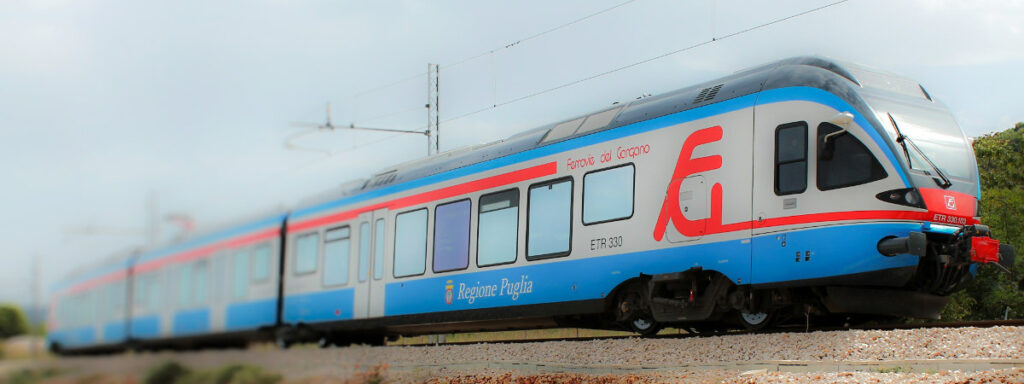
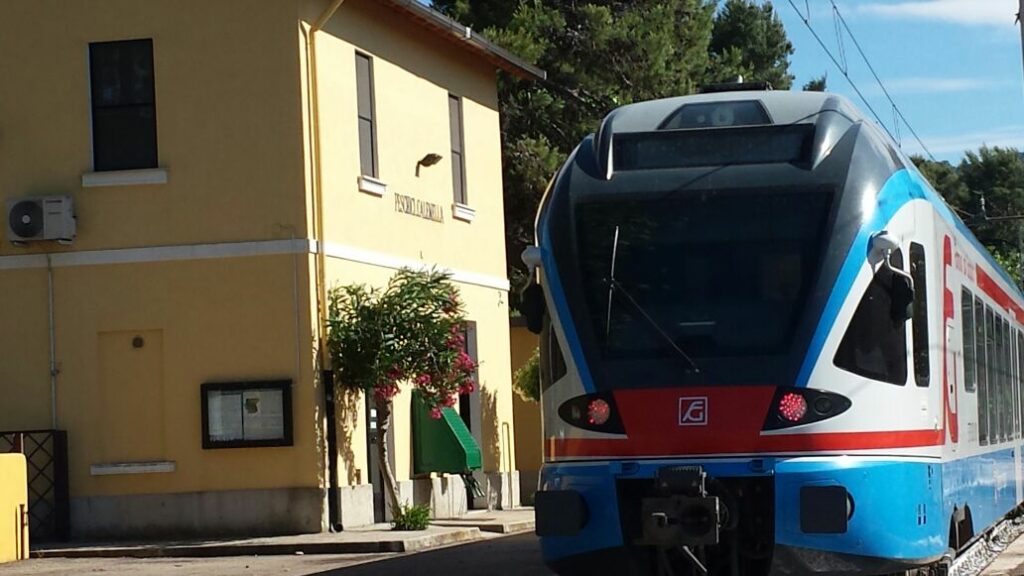
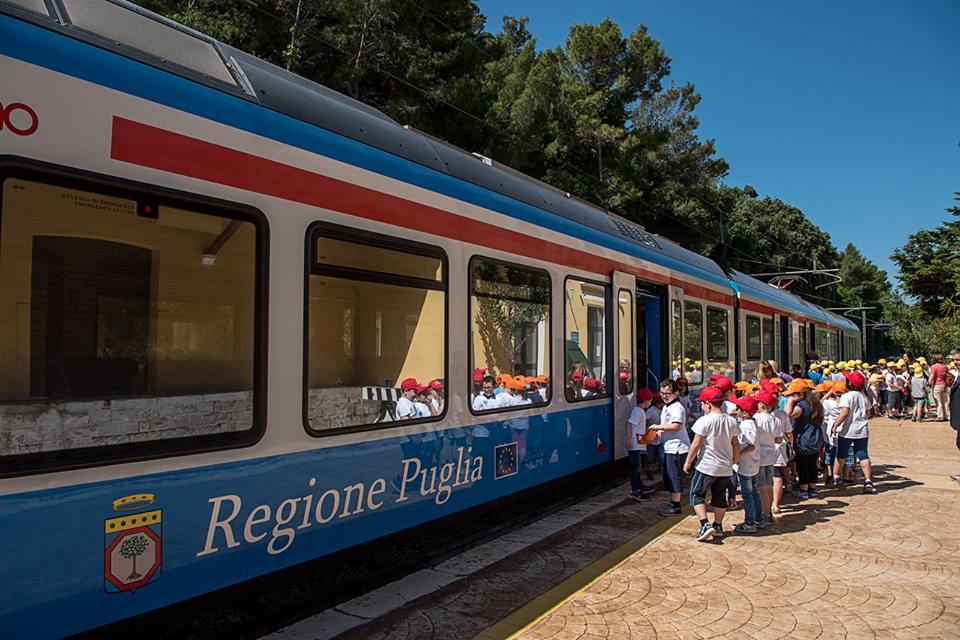
***
Ferrovie Nordbarese/Ferrotramvaria
This is a private company, Ferrotramviaria SpA, set up in 1937. It uses both the above names, running important rail and bus services north of Bari from a terminus in Piazza Aldo Moro, next to Bari Centrale, the main Bari station on the FS national network. There is a second connection with the FS network at Barletta, within the main station.
There are four lines:
red – this essentially serves the Ospedale San Paulo, an enormous health care facilty on the outskirts of Bari, one of the largest hospitals in Europe (so hopefully visitors will have no need to use this line)
grey – linking Bari with its Airport, Bitonto, Corato, Andria and Barletta; not only useful for the airport, the towns it serves are all interesting places to stay and visit, with Andria also being the station nearest to Castel del Monte
yellow – essentially the same as grey, but only running as far as Bitonto
blue – essentially the same as grey, but it follows a slightly different route out of Bari and does not serve the airport.
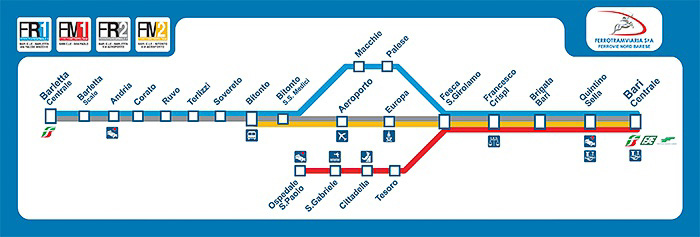
Apart from the important airport connection, visitors to Puglia will be mainly interested in the opportunity to reach the inland towns between Bitonto and Andria (from which it is possible to reach Castel del Monte by bus).
There has been considerable investment in the track and the rolling stock recently. The trains are smooth, comfortable and stylish.
There is a general website for the FNB hich gives lots of information, news,updates on any problemns etc. The home page contains a good timetable search facility for specific trips. There is a link to a page on routes and timetables, to reach this directly click here; from the page reached there are links to pdf versions of the full timetable, which may be useful, this can be downloaded or printed if required.
Tickets can be booked on line, but there are ample outlets in ticket offices at the staions, bars etc and machines. Fares are cheap except for the Airport - so a fare to Bitonto will be 1.50 euros, while to the Airport (a nearer station) it is over 5.00 euros. This is presumably to capture the revenue generated by airport traffic - we have never tried getting off at the Airport with a cheaper ticket through to Bitonto however!
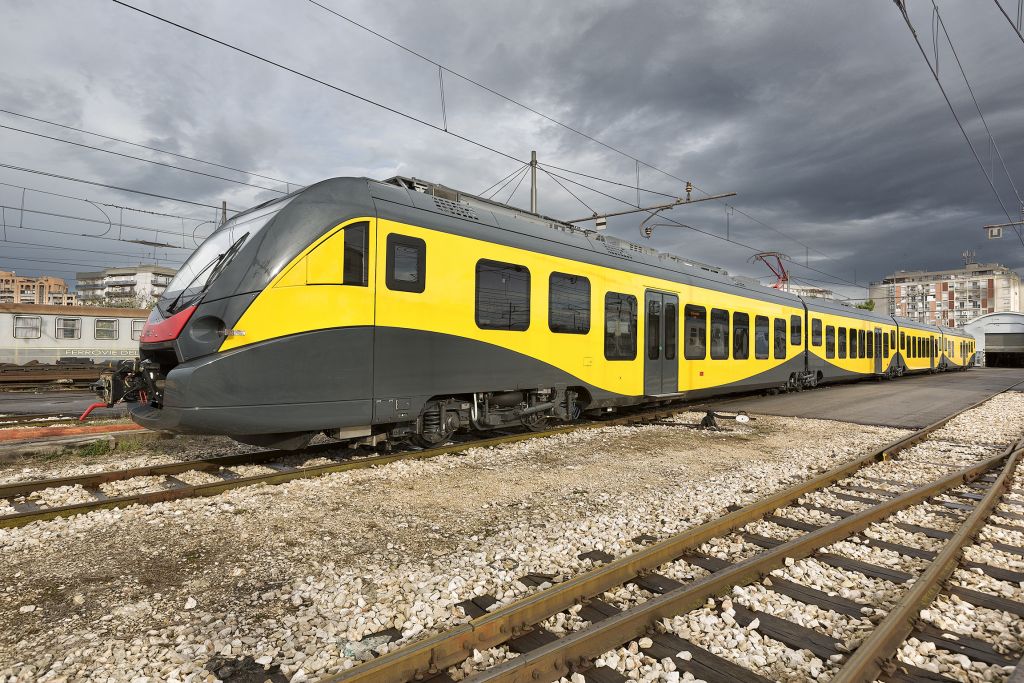
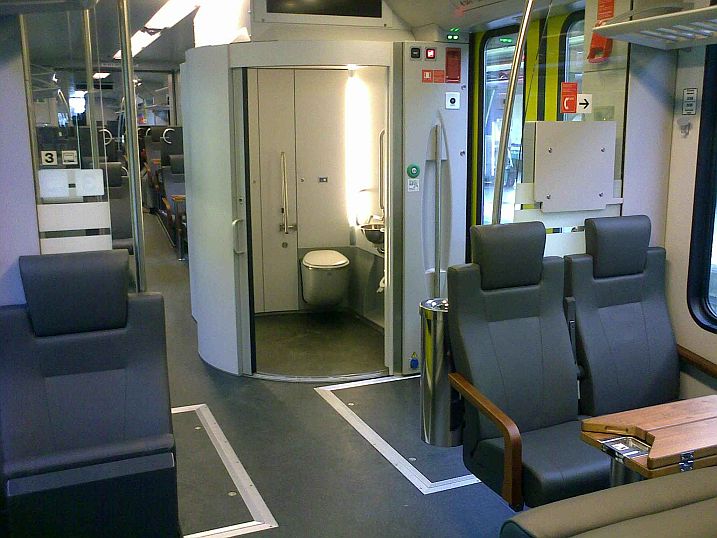
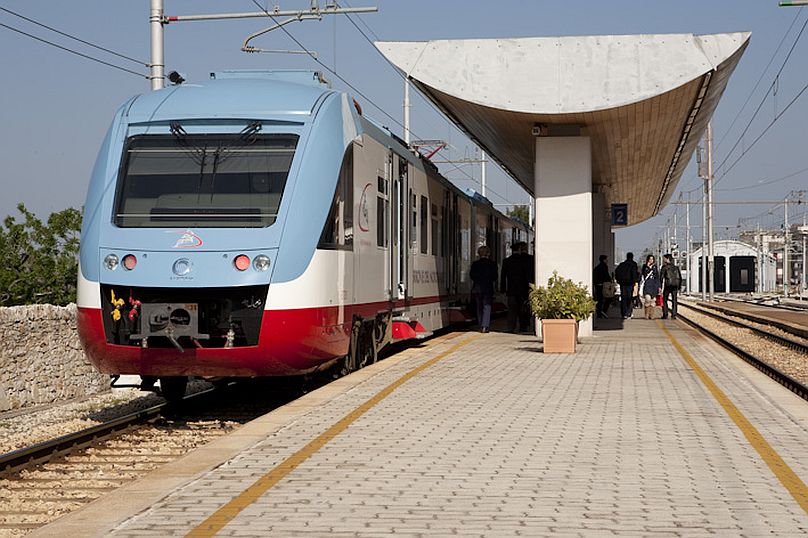
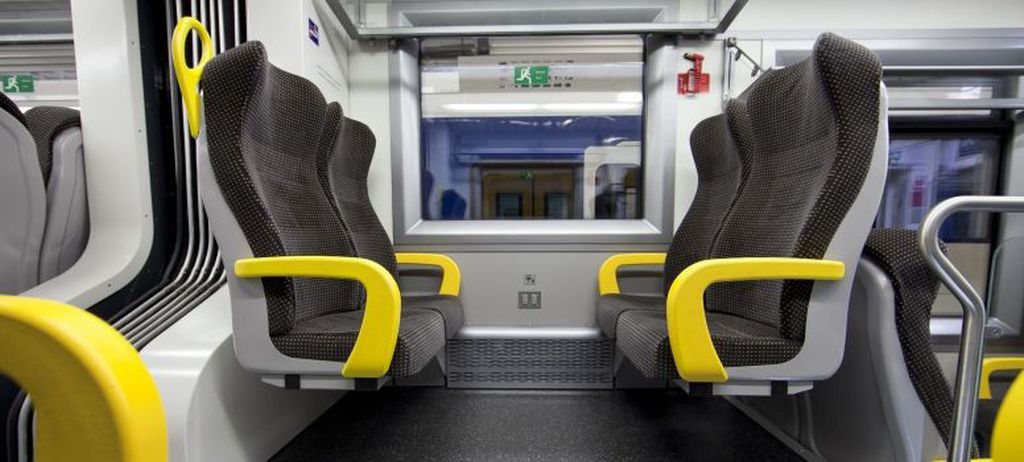
***
Ferrovie Appulo Lucane (FAL)
This narrow-gauge (0.950 m) railway network is a remnant of a project to link the Tyrrenhian, Adriatic and Ionian coasts of Puglia, Basilicata and Calabria. It was built in the first half of the 20th century by the Società Italiana per le Strade Ferrate del Mediterraneo. The Basilica and Puglia sections were inherited in 2001 by the current company, Ferrovie Appulo-Lucane SrL. (Appulo is an old name for Puglia, Lucane an old name for Basilicata) This private company operates three lines:
- Bari – Altamura – Matera
- Altamura – Avigliano Lucania
- Avigliano City – Potenza
FAL's Bari base is in Piazza Aldo Moro, next to the Ferrotramviaria Nord Barese (FNB) station, adjacent to Bari Centrale station on the main FS national network. From here train services link Bari with Altamura, Gravina, Potenza and Matera. It provides in particular an important link to Matera, which is just over the regional border into Basilicata. Altamura and Gravina, both within Puglia, are also interesting towns well worth visiting.
FAL has a general website . The home page includes an effective timetable enquiry facility. We especially like the very full information displayed when the "details" button on the displayed timetable options come up - this specifies where you need to change, where there are substitue buses etc. (NB If you are travelling to Matera, it is usual to "change" at Altamura because the train from Bari divides into sections there, one for Matera, one for Gravina. Visitors to Matera should use Matera Centrale, there are a couple of other stops in Matera).
The website home page also contains an updated strip giving information about problems, delays etc. There are links on the website to full timetables, but these are tricky to understand, and may be out of date - we advise sticking to the enquiry system on the home page.
Tickets can be purchased at offices at main stations, from machines and from bars etc. There is a facility on the website - click here - which tells you where tickets can be bought at any stop on the network - you may need to use this if you are going to a small place where there might not be a ticketing option on the station itself.
There is a good and reliable service from early morning until late at night. The diesel trains are modern and efficient, with clean, comfortable coaches. The narrow guage gives them an interesting "feel". There are many stops at small places once clear of the Bari suburbs, but the stations are neat and well organised. Between Altamura and Matera the line runs through the bleak and unpopulated Murghe hills, a contrast to the trip up from the coastal plain.
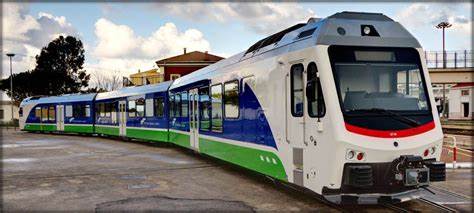
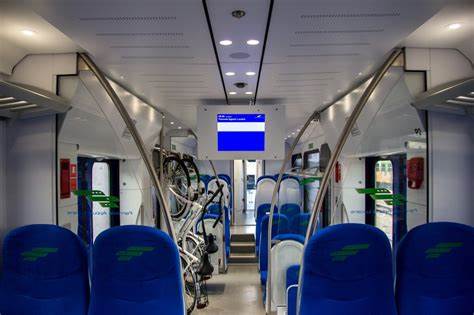

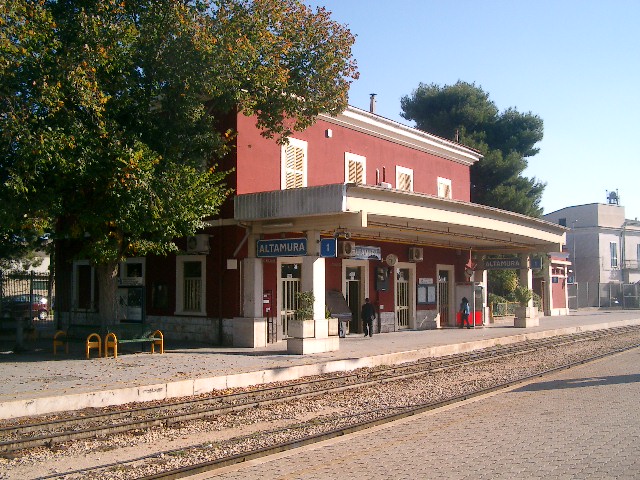
***
Ferrovie del Sud Est (FSE)
This is the most extensive of the independent Puglia rail networks, and with 474 kilometres of track it is the largest network in Italy after the FS state railway network. The system involves a string of railway lines developed independently over a period of 75 years from about 1850 onwards. In 1931, these were brought together and incorporated into the single company, Ferrovie del Sud Est. Following some years of financial difficulties, the company was taken over by the main state railway system, FS in 1916. Although it is still operated and managed as an independent entity, its systems are increasingly being absorbed into the national network. (NB The integration of online timetable enquiries and booking has caused problems - these and how to deal with them are explained below).
The routes extend south from Bari to Putignano, Coversano, the Itria valley, Martina Franca and Taranto; and from Lecce south into the Salento, covering Maglie, Gallipoli, Otranto, Gagliano del Capo (for Santa Maria di Leuca, the “tip” of Italy’s heel), Tricase and lots of other places. Martina Franca FSE station is the link between the "northern" and "southern" parts of the network, and although there are some through trains, travelling between the Bari and Lecce based networks will normally involve a change at Martina Franca (trains are almost invariably timetabled to facilitate this).
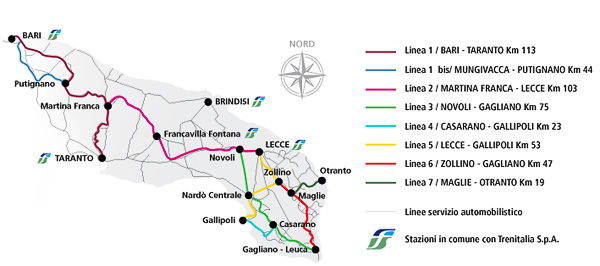
Lines are standard guage. Most of the trains use diesel units but very recently the Bari-Putignano link has been electrified, a major investment project, using modern electric trains - see picture here.
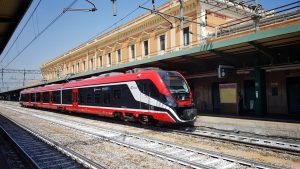
Otherwise the carriages are of mixed quality and "heritage". There are a number of modern, sleek and very comfortable units. But these are mixed in with older vehicles, although the very old rolling stock seems to have mainly disappeared to be replaced by carriages becoming surplus from the FS regional trains as these are replaced by modern carriages. This presents a problem for people with special access needs (eg disabled people, those with bicycles), who can be easily accommodated as routine on some trains but not on others. You can contact FSE via options on their website contacts page if you do need specific assistance or information. This includes specific information to assist people with diabilities or reduced mobility.
The key termini and connections with the national system are inside the main stations at Bari and Lecce – on separate platforms at one side of the staion in both cases. There are also stations shared with the main FS state railway system in Taranto and at Francavilla Fontana; otherwise the whole network is completely separate from the national system.
Investment and improvements in recent years have had a big impact on punctuality, reliability and service levels. Nevertheless, the FSE retains a lot of its traditional "quirkiness". It is quite often necessary to change trains at the somewhat isolated junctions such as Novoli, Zollino, Nardo Centrale. Slow speed is normal, so you get plenty of opportunity to see the somewhat desolate, deprived countryside of southern Puglia. Because coastal areas of Puglia were in the past covered in marshes, almost all the network is inland. There are lots of stations, many very primitive; some of them serve towns/villages but are themselves in isolated locations (so the advice to check on how to reach your destination after getting off the train is more than usually important). Although there are indicators at the bigger stations, even there it is worth confirming the route and destination of a train as you get on it, and make especially certain you are on the right train as you arrive at a junction - if you go in the wrong direction this can be very awkward to rectify. There are usually staff on the train checking tickets etc, and they are invariably helpful. Overall, despite the modernisation which is proceeding all the time, travelling on the FSE has a delightful, old fashioned feel about it, adding an enjoyment which makes up for the occasional shortcomings like a missed connection or delayed train.
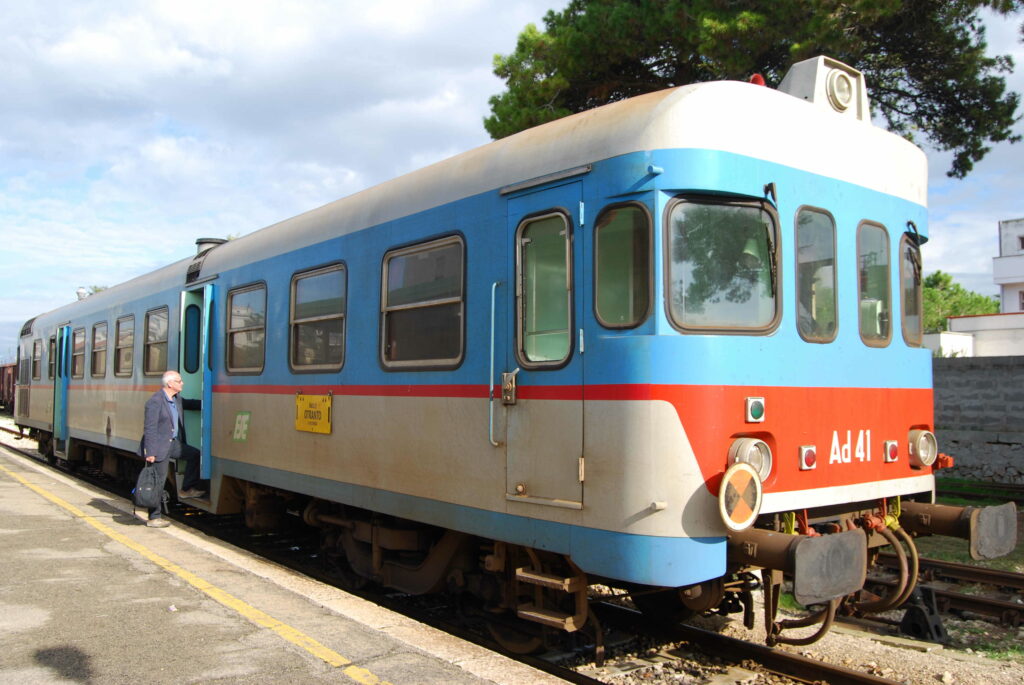
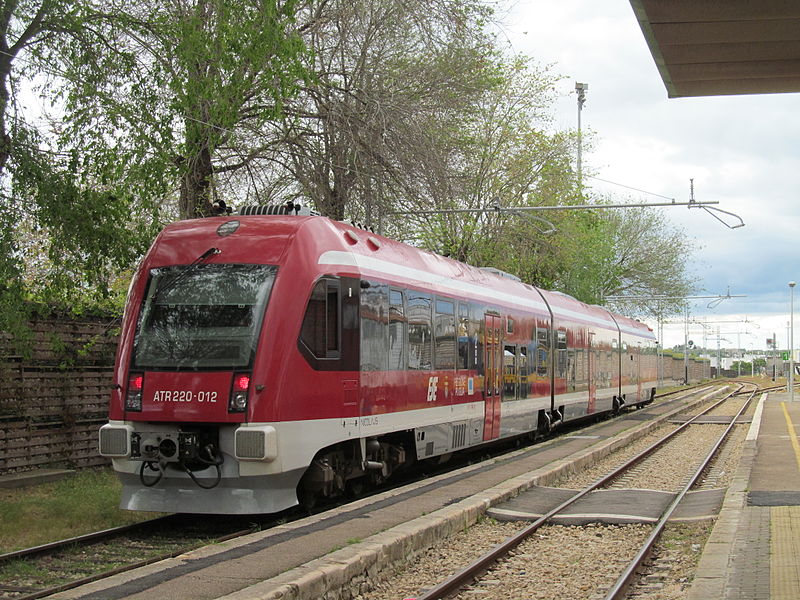
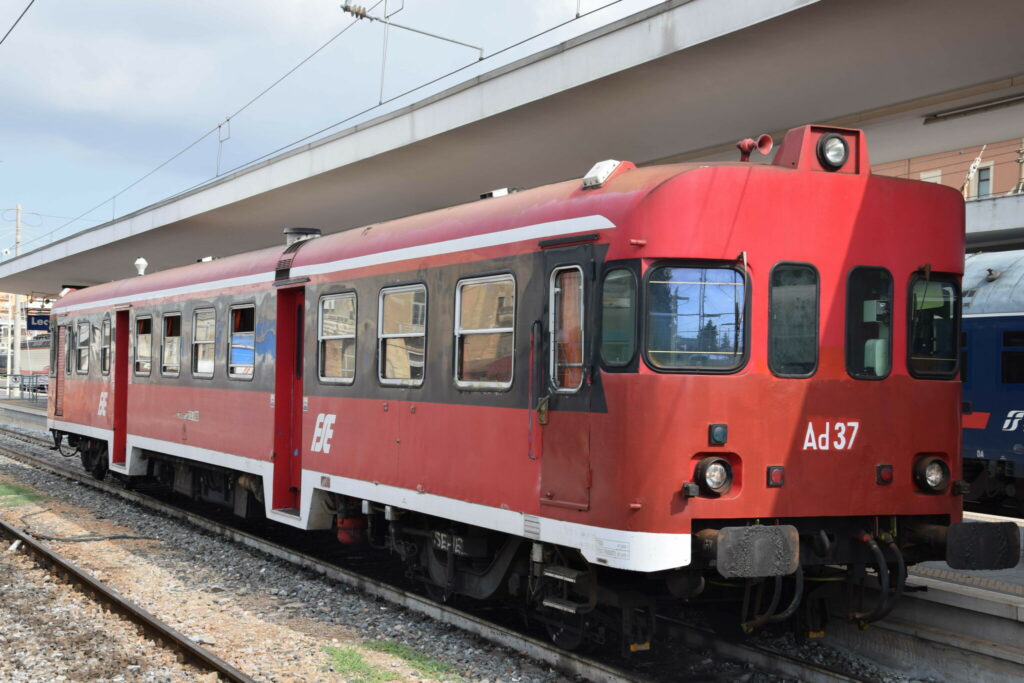
The FSE has its own website (Italian only so far as we can tell), although this now has the FS logo and describes the FSE as part of the state railways group. The home page contains a standard timetable enquiry/booking system, the same system as on the FS/Trenitalia website for national railways. It also covers the important bus services operated by FSE; this is very useful, as there are sometimes bus service options which are better than a journey by train - but see our important warnings about this below, the integration of bus and train options into the FSE/Trenitalia website has caused some problems. It is also possible to use the main FS/Trenitalia website to look up and to book online journeys using the FSE. Additionally there is a page from which it is possible to download full current timetables of bus services and train services - click here to reach this page.
You can look up timetables and to book online for trips between a FS mainline station (eg Bari Centrale, Monopoli) and a FSE station (eg Tricase, Gallipoli). On the FSE website these enquiries seem to only be allowed for travel involving FS stations within Puglia, and also seem to feature Regional train options only on the mainline sections. If you want to travel from a mainline station to an FSE station (or vice versa), our advice is to consider this as two "legs", with a search for the mainline leg to/from a FSE terminal (normally Bari or Lecce) using the Trenitalia website; and a separate search between this terminal and your FSE destination/departure station using the FSE site. This would also apply to ticket purchases, even though you can purchase through tickets involving both the FS and FSE networks (NB there is no price difference if you do this).
FSE runs extensive bus services as well as trains. So if you are travelling in that large proportion of Puglia territory covered by FSE the combination of FSE trains and buses will feature strongly. Currently these buses are not covered by the COTRAP system, so if you use the COTRAP website to make a search for bus routes, you must also make sure you do a parallel search on the FSE/Trenitalia system.
Although the FSE trains and buses are all managed by the same company, and share a website etc, they operate quite separately. It is quite usual for FSE bus services and FSE trains to have separate termini in the same town; usually the bus terminus or bus stop is in the centre of the town, the railway station can be on the outskirts or even some distance away.
Now that the FSE is a semi-independent part of the national railway system, enquiries on the FSE website link into the main FS/Trenitalia website to generate options and fares. The Trenitalia website gives information about all FSE services, buses as well as trains; and when you do a search on the FSE website, it comes up with the same information as a query via Trenitalia. So when specificying a departure or destination on the website, you will be presented with options for stops/stations involving the FSE buses and trains as well as any FS stations. This is confusing - in the past when specifying travel involving for example Lecce, only one option was shown, which was Lecce main railway station; now there are whole string of options, most of them bus stops in various parts of Lecce!
This integration of trains and buses into the single FSE/Trenitalia website search facility has also made the search facility less effective. The search engine currently produces route options relating to precisely the stations/stops you enter, which can generate very bizarre results when there is a much more obvious answer if a nearby alternative station/stop is entered. Our advice is to do searches from what seem to be the main rail station (usually just giving the name of the town) and the main bus terminus (which may not be at the rail station, and even if it is may have a different name!).
So when you are presented with a choice of departure or destination stations/stops which relate to your enquiry, be very careful about what you specify; and make several searches to find the best option by rail, by bus and/or a combination. In particulat look at the time taken and the route/number of changes.
FSE tickets can be booked on line via the same system as timetable enquiries. However there should be no need to do this as there are ample opportunities to buy tickets at dedicated sales points at the main stations; at bars and restaurants in or near stations; at ticket machines on most stations. The FSE website has a useful feature which
- lists its stations which have ticket machines - so if your station is not listed you will need to get a ticket somewhere else or be ready to pay on the train
- access to information about outlets which sell tickets, including places away from the stations themselves; to use this tool, on the website page click on LIS, which throws up a map of Italy with a search space superimposed and a menu on the left hand side; on the menu click on "Pagamenti", then scroll down and tick "Bigletti Viaggio"; when you have done this, type the name of the place in which you are interested into the search line and click to search, the map will focus in on the details and the location of all the outlets in the place you have specified.
If you are boarding a train at a station without any facilities, then you can pay on the train. In days gone by there was little attempt to check tickets on the FSE trains, but this is no longer the case, so you must either have or be ready to pay for a ticket. At the main termini, you may be asked to show your ticket as you board. Always validate your ticket shortly before boarding at one of the validation machines on the station.
FSE has an update page on its website - click here to reach this - which gives updated details of changes, delays etc. If you are relying on a specific train, it may be sensible to check this before you travel. It also has a good contacts page where you can make enquiries in different ways, including webchat contaccts.
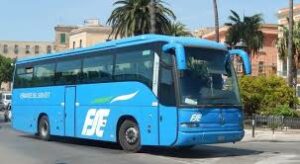
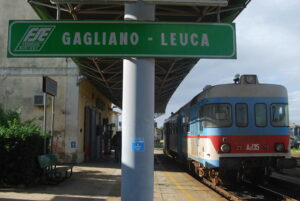
***
GETTING AROUND PUGLIA BY BUS AND COACH
Here we give detailed advice and information about getting around Puglia by bus/coach. There are several public and private companies which are relevant, including bus services run by the national and four regional rail companies. The details of these vary, so we deal with each of them in turn, working roughly north to south. Several, but unfortunately not all, operate a joint timetable enquiry/booking system cqalled COTRAP; you need to be familiar with this, but its website is slightly diffcult to use, so we give specific advice on this.
You can scroll down or jump to particular sections by clicking on the links below.
- General information
- Bus services operated by Ferrovie del Gargano (FdG)
- ACAPT
- Sita Sud
- Bus services operated by Ferrotramviara/Ferrovie Nord Barese (FNB)
- Bus services operated by Ferrovie Appulo Lucane (FAL)
- Freccialink services operated by FS/Trenitalia
- STP Bari
- Bus services operated by Ferrovie del Sud Est (FSE)
- STP Brindisi
- STP Terra d'Otranto/Salento in Bus)
- Salento in Bus (mid June - mid September)
- COTRAP and how to use its website
***
General
In addition to the dense coverage of Puglia by the local rail network, there are also many bus services. These provide an alternative to train connections sometimes, but more importantly bus services reach many places beyond the railway coverage. Unfortunately, finding information about bus services can be tricky. This website should help a lot.
Bus companies operating in Puglia
Bus services are provided in various parts of Puglia by a number of private and public bus companies. The most significant of these are SitaSud, ACAPT, STP Bari, STP Brindisi, STP di Terra d'Otranto (which also runs summer services branded as "Salento in Bus").
Bus services run by the railway companies
Additionally, and slightly confusing, is that all four of the Puglia regional rail companies (Ferrovie del Gargano: Ferrotramviaria/Ferrovie del Nord Barese; Ferrovie Appulo Lucane; and Ferrovie del Sud Est) operate extensive bus networks as well as trains. These constitute a huge element of the public transport network. Two of these - Ferrovie del Gargano and Ferrovie del Sud Est - are especially significant for visitors. It is essential to know what they offer in the relevant parts of Puglia.
A further complication is that the regional railway companies all use rail replacement bus services on Sundays and some public holidays. These replacement services follow a rail timetable, and run directly between railway stations, unlike their "normal" bus services which follow quite separate routes and have fairly frequent stops. So in effect these bus services can be regarded as part of the rail network, covered elsewhere on our website.
It is sometimes annoying that the bus services (but not the rail replacement buses) operated by the railway companies do not necessarily link up with the rail services they also run or the rail stations they serve! They often use a quite separate bus stop or bus terminal in the same town. For instance, the Ostuni-Ceglie Messapica service, operated by FSE, runs from Viale della Sport in Ostuni’s shopping centre centre (a long way from Ostuni’s railway station!) into a terminal next to Ceglie hospital near to the old centre of Ceglie; on the way the bus actually drives near Ceglie’s FSE rail station although does not stop there or go past its entrance.
In this part of our website, we give information about bus services operated by the railway companies as just additional bus companies.
COTRAP
In order to promote use of bus services, a consortium of bus operators has been established with a common timetable and enquiry system - COTRAP.
This is a great idea in principle, but unfortunately it just covers bus options when train based options may be better; and the extensive bus services run by some rail companies, in particular the important FSE services, are not currently on the COTRAP system and enquiries will not throw up options which involve bus services offered by these operators. Furthermore, the COTRAP website is quite awkward to use. It is however often impossible to make enquiries about bus journey options without it. For this reason we provide below some specific guidance and various tips for using the COTRAP website.
***
Bus services operated by Ferrovie del Gargano
The FdG runs some bus services in the Gargano peninsula, in particular an important service connecting San Severo with Vieste, travelling along the north side of the peninsula via Pechici.

To get information, use the home page of the FdG website Italian version Just below the hearders this site allows you to access pdf versions of its railway and bus networks. The pdf for buses gives full details of the important San Severo-Vieste service (among others). NB The foreign language versions of the website do not appear to give access to these pdf timetables.
The home page also provides a timetable search facility for railways and buses. To get information about bus services, check "extra-urban services" and "consult the timetables". For buses this automatically refers users to the COTRAP website; if you want to use this, refer to the guidance and notes we give below.
The home page of the FdG also contains a very useful feature. There is a constantly updated panel at the right hand side with important news of closures, holidays, breakdowns, changes, cancellations, replacement services etc. If you are travelolling on any of their services, it is worth checvking with this just before you travel. By clicking on any of the notices which seem relevant to your trip, you can see full details.
There is no need to buy tickets on line, but if you want to do this then you can do it via the COTRAP website. You can buy tickets at many places, you can get a list of sales outlets via the FdG website, click here.
***
ACAPT
ACPT is a family-owned travel company based in Apricena, with roots going back to 1912. It has a fleet of modern coaches, providing services around Foggia. Many off these services are for school and work travel purposes. However, ACPT provides liniks of value to visitors, including especially a connection to Bovino, which is officially recognised as one of "the most beautiful villages in Italy". It also provides an alternative to the train services to towns and villages north of Foggia.

ACAPT has an attractive website home page which lists the destinations served with pictures of each. There is also a link to a full set of timetables, this can be downloaded. The "News" page which can be accessed from the home page gives up to date information about changes, cancellations etc.
There is no facility on the website for booking tickets online, although this can be done if preferred via the COTRAP website. You do have to be in a possession of a ticket before you board a bus (although we suspect that purchase on board is possible). There are plenty of places which sell tickets however, with a list provided on the website - click here Tickets must be validated in a machine on board the bus. There key Foggia stops are immediately outside the FS station and there are several ticket purchase options there.
***
Sita Sud
Sita Sud is the Puglia branch of an established national bus and coach transport company. (Sita busesand coaches are a familiar sight throughout Italy). It is an important provider of services based on Foggia and Bari (although the Bari based services extend to the west of Puglia beyond Taranto and include a few useful servies in the far south of Puglia).
We do not advise using the Sita Sud services operating from Bari itself; there are better options available. Howver, some other services classified as in the Sita Sud Bari area are useful. The Foggia based services are more valuable, and are especially significant in the Gargano peninsula.
The Sita Sud bus fleet is modern and comfortable.
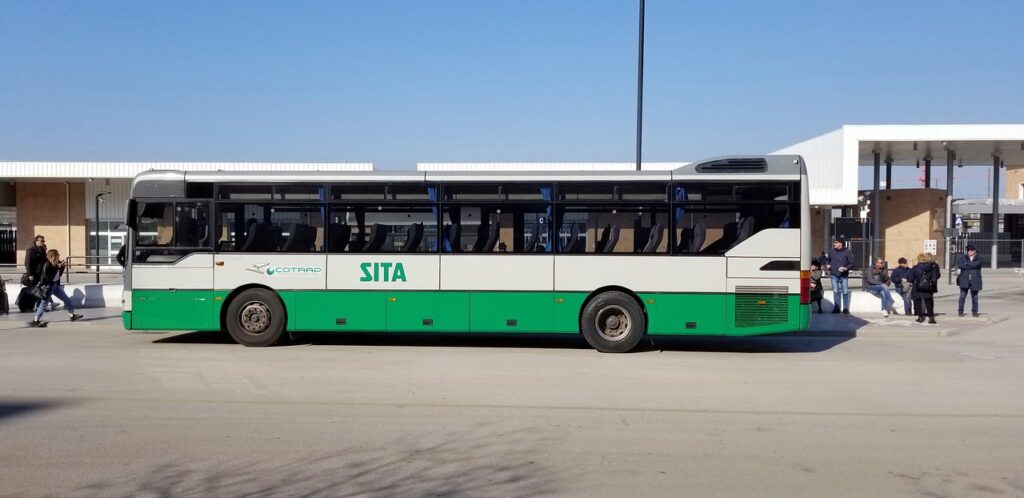
Access the Sita Sud website home page here We have found this website to have occasional display problems. Our instructions here will help; if you encounter problems, try again.
At the very top of the home page is a drop down indicator allowing you to select Puglia information (Sita Sud also operates in Calabria and Basilicata). This displays a home page which relates to Puglia services.
The home page gives updates about any problems, delays, changes etc; these are displayed as "customer notices" in the body of the page. It is worth checking on this shortly before you travel if you are aiming for a particular Sita Sud bus service.
It is possible to get timetable details, but this is not easy, as Sita Sud has handed over its search facility to COTRAP. To get downloadable/printable Sitasud timetables, take the following steps:
- on the home page, click on the link at the top for "timetables" ("orari")
- ignore the departure/destination search boxes; below that there is a choice between Foggia and Bari based information; select "Foggia" for the services in the vicinity of Foggia and in the Gargano, select "Bari" for services elsewhere
- there follows a long list of routes, each with links inviting you to book "prenotata" online, which just link to the COTRAP website; and a link to a pdf timetable version for that particular route, which provide a useful overview of options (NB some of these pdf links lead to a notice saying use the COTRAP website instead, but most of them work, and you can download/print any timetables of particular interrest). NB The lists of timetables are quite long, and not in any particular order, so don't give up, keep scrolling through until you find what you are looking for!
In this way you can get timetable information about links between Foggia (and in some cases Bari) and most of the places of interest in the Gargano peninsula; San Severo; Lucera (an alternative to the train service). The Foggia-Manfedonia-Vieste bus service is an important option, the route goes via Manfredonia and then around the south coast of the Gargano, an alternative to the rail/bus routes from San Severo via Peschici. There are also listed various other routes in the south and the west of Puglia where a few Sita Sud services operate.
The timetables currently (mid 2025) refer to coming into force in 2024, which is slightly discouraging, but this is an update to the earlier version which suggested they dated from 2020. Once you have a route option in mind which seems suitable, it is worth following up with a specific timetable enquiry using the COTRAP links provided.
As well as booking on line, you can book on board buses, or better still purchase at an outlet near a bus stop - the Sita Sud website gives a list of ticket vendors You can get a full list of those in the Foggia or Bari based areas or specify a particular place. Tickets must be validated on a machine on board the bus.
***
Bus services operated by Ferrotramviaria/Ferrovie del Nord Barese
The bus services run by the FNB essentially parallel its railways services between Bari and Bitonto, Andria and Barletta. We recommend using the train services to visit the various places served.
In case anyone is interested, a current timetable of services is available on the FNB website. This can be viewed here - bring up the page then scroll down to where its says "bus timetable" ("autolinee") - it may also say summer/winter timetable. This brings up a full timetable. Most other relevant information is also available on the same page of the website.
***
Bus services operated by Ferrovie Appulo Lucane
The FAL runs bus services between Bari, Gravina, Matera and Potenza. These essentially duplicate the train services, and as we recommend using the train to reach the places served, no specific information is given here. If you are interested look up the bus service information which is also on the website details given in relation to the rail options.
<
***
Freccialink coach services provided by Italian state railways (FS)
This developing coach connection service is run by the national FS railway system. The intention is to link main stations served by Freccia trains to important destinations beyond the Freccia network. These links can be booked in a straightforward way via the FS/Trenitalia main website, but only in conjunction with a Freccia train ticket (ie they cannot be booked for specific independent trips).
Currently (2024) there is only one such service operating in Puglia. From 9 June until 15 September, there is a service on Fridays, saturdays and Sundays only, connecting Foggia with Pechici and Vieste on the Gargano Peninsula. This quicker than the Foggi-Vieste shuttle bus service.
Two other Freccialink services are metioned here because they have been run in previous years and may be resurrected:
- a link from Bari Centrale to Matera (NB there is also a Frecciabus between Salerno on the west coast of Italy and Matera calling at Potenza, this still functions)
- a summer service linking Lecce to Gallipoli and Otranto.
This link to the Trenitalia website (Italian version) provides information about the Freccialink services. It will be updated if these services in Puglia are re-introducedand/or new ones added.
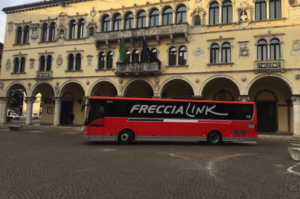
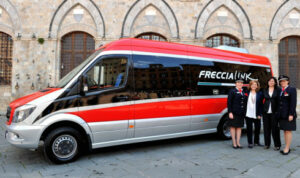
The Freccialink service uses comfortable long distance coaches and minibuses; the quality of service is meant to match the Freciarossa trains. They run non-stop between the few designated termini.
***
STP Bari
This company runs a network of bus services around Bari; northwards to Andria, Barletta and Cerignola; westwards to Matera and Gravina. However, they are local services not especially convenient for vistors to Puglia, and anyway the area they cover is better served by the train services.
The main possible advantage is that STB Bari runs some direct services between places outside Bari eg Trani to Andria. This link to the STP Bari website home page allows you to downoad a full timetable if you think its services might be of interest.
***
Bus services operated by Ferrovie del Sud Est
The bus services operated by FSE are a massive part of the Puglia transport newtwork. They cover the inland area between Bari and Lecce, and extend south of Lecce to cover the whole of the "heel" of Italy. So if you are travelling in that large proportion of Puglia territory, the combination of FSE trains and buses will feature strongly. And currently these buses are not covered by the COTRAP system, so if you use the COTRAP website to make a search, you must also make sure you do a parallel search for options offered by FSE.
The FSE website gives information about bus services and rail services. Use this for obtaining up to date information, lists of places where you can buy tickets etc. However, the timetable enquiry and booking system, for buses as well as trains, is now integrated with the FS/Trenitalia system. This has caused some significant problems for users which hopefully will be resolved in future; in the meantime we give some tips to handle this below.
Although the FSE trains and buses are all managed by the same company, and share a website etc, they operate quite separately. It is quite usual for FSE bus services and FSE trains to have separate termini in the same town; usually the bus terminus or bus stop is in the centre of the town, the railway station can be on the outskirts or even some distance away. In the larger towns, there are often a number of bus stops, it is not always simple to spot the main one.
Now that the FSE is a semi-independent part of the national railway system, enquiries on the FSE website link into the main FS/Trenitalia website to generate options and fares. In addition to information about FS/Trenitalia national rail services, this website also gives information about all FSE services, buses and trains. So when specificying a departure or destination on the website, you will be presented with dropdown options for stops/stations involving the FSE buses and trains as well as any FS stations. This is confusing - in the past when specifying travel involving for example Lecce, only one option was shown, which was Lecce main railway station; now there are whole string of options, most of them bus stops in various parts of Lecce!
This integration of trains and buses into the single FSE/Trenitalia website search facility has also made the search facility in general less effective. The search engine currently produces route options relating to precisely the stations/stops you enter, which can generate very bizarre results when there is a much more obvious answer if a nearby alternative station/stop is entered. Our advice is to do searches relating to what seem to be the main rail station (usually just giving the name of the town) and the main bus terminus (which may not be at the rail station, and even if it is may have a different name!). Make several searches to find the best option by rail, by bus and/or a combination. In particulat look at the time taken and the route/number of changes.
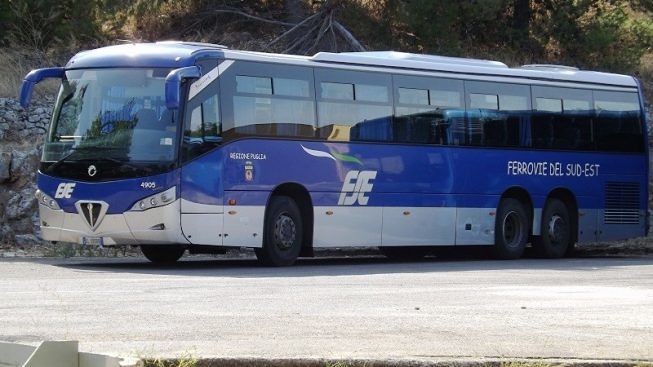
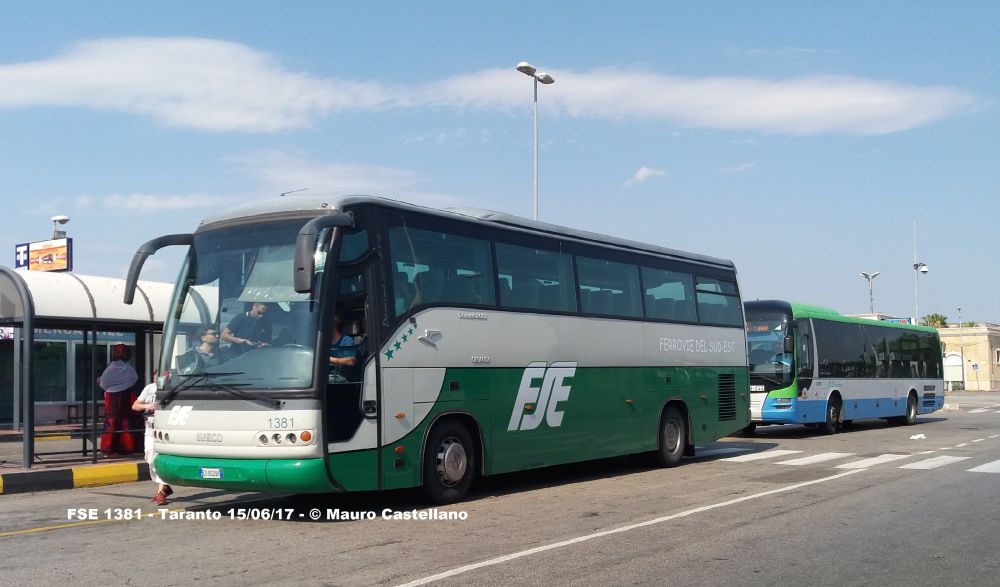
***
STP Brindisi
STP Brindisi is a publicly owned company formed about 30 years ago from various private and public transport agencies. It runs extensive "out of town" ("extraurbani") bus services throughout Brindisi Province and in the area bounded by Fasano, Brindisi, Lecce and Taranto generally. It also runs urban services in Brindisi city, Ostuni, Francavilla Fontana and Mesagne. Interestingly it is also responsible for two motor boats which operate as public transport in Brindisi Harbour
Although a very important transport operator in ts area, the service routes and timetables are mainly aimed at local people - for work, shopping and school. This limits its value to visitors (unless you are ready to travel at awkward times). There are a few extra services in summer which help a little, and also some specifically seasonal services (some of them free) linking coastal resorts to Ostuni.
STP Brindisi has a helpful website, which gives full timetable details. Navigation is slightly quirky. The following tips will help:
- from the Home Page click on the three bars symbol to show the main menu, scroll to "Lines and Timetables", then to "Out of Town Services" - the link here will take you straight to the page this generates
- scroll down to any of the 27 towns/places in which you are interested; clicking on this wioll throw up a list of all the routes which serve that particuar location
- click on any route which is relevant to you, this leads to a PDF file with full timetable details for you to look at and download (for printing if you want)
- you may find that trying to move backwards on the website keeps sending you to the Home Page - a nuisance, but you just have to go back to where you want to be!.
Although there is plenty of timetable and route details on the website, there is no online booking facility - for this you will need to use the COTRAP website (however, with proper timetable and route information, you will be able to use this effectively). STP Brindisi tickets are widely available in bars etc throughout the area served. You can also purchase tickets on the buses, from the driver or from machines (NB they are just starting to introduce contactless card payments on some buses).
The out of town buses are mainly comfortable coaches.
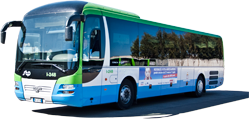
***
STP di Terra d'Otranto
This company (Societa Trasporti Pubblici di Terra d'Otranto) was formed in 1976 by merging some pre-existing transport operators in the area around Lecce and the south of Puglia generally, where it now provides significant bus services. The company is mainly owned by the government of Lecce Province.
The company has a website, access the home page here. This is fine for things other than timetable enquiries and bookings. The poor map below is available on the website; this gives an idea of the area covered and the main routes.
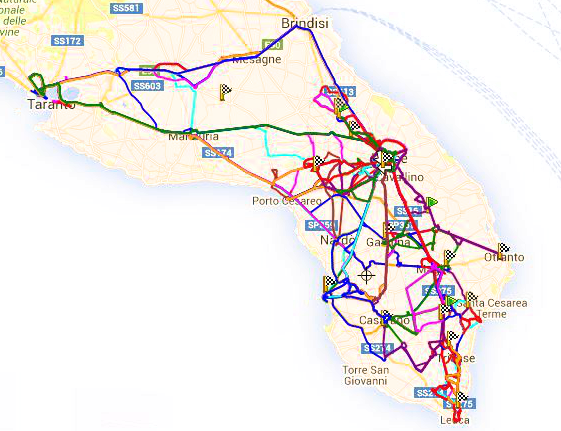
The STP di Terra d'Otranto website timetable search and booking facility refers you automatically to the COTRAP website (see our notes on how to use this). This is fine for anyone who has a clear idea of their departure and arrival points. It is less useful for more casual exploration of options etc.
In the period mid June-mid September, it makes sense to look to the Salento in Bus options operated by STP di Terra d'Otranto, see below. Outside this period, or for places not covered by the Salento by Bus network, to find out information on STP di Terra d'Otranto services it is necessary to use the COTRAP website. As well as the general tips about using this website, here are a couple of specific tips:
- outside Lecce, you may find it useful to look at options based on stops near Ferrovie del Sud Est (FSE) railway stations
- make sure you use stops/terminals specified for STP di Terra d'Otranto, not Salento in Bus; these are different, as outside the summer season terminals less convenient for visitors are used
- if the stops available in Lecce are not convenient for the trip you have in mind, see if there is an alternative from Maglie, which is easily reached by FSE train from Lecce and where there is a stop a short walk from the station
- in Lecce, look at the map of stops available (ie labelled as being stops used by STP di Terra d'Otranto); there may be a stop more convenient for you than the Capolinea, which is convenient for workers but not for visitors.
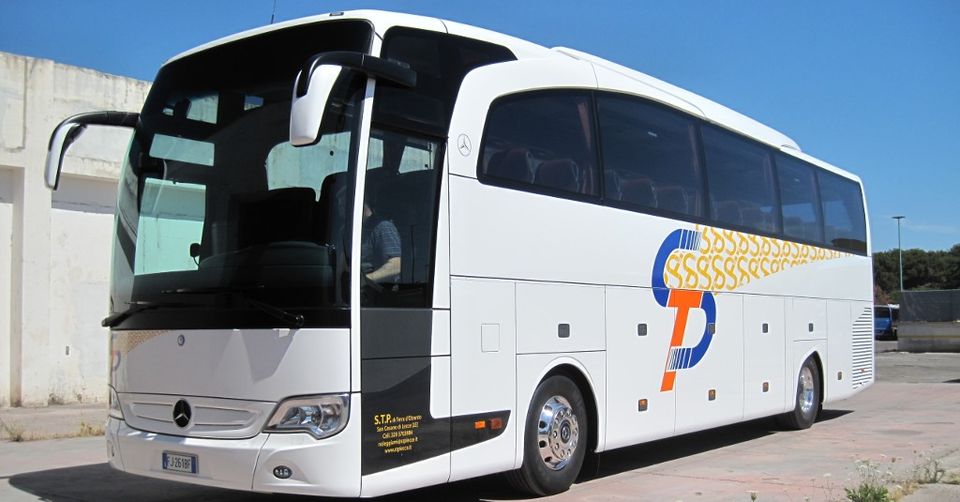
South of Gallipoli/Maglie/Otranto, bus travel outside the summer season is quite a challenge, so be prepared to research options carefully. We provide some advice above about how to reach specific places; this may help.
***
Salento in Bus (mid June-mid September)
In recent years the STP di Terra d'Otranto company has established a comprehensive network of summer services catering for visitors to the area promoted under the title "Salento in Bus".
This operates mid June to mid September, with extra services in July and August. The map below shows the lines, and there are very comprehensive timetables available for the services shown - for some reason these are not referred to on the main STP di Terra d'Otranto website, but are available on a separate site, click here.
By scrolling down on this site, you can view detailed timetables for all the routes shown on the map - keep scrolling down and when you get to the details of the routes, click on the one you want to look at. The same website provides a list of locations to buy tickets for each route, and also full details of telephone numbers to ring for assistance to disabled people (normally 24 hours notice is needed). There is a link for you to book online, but this takes you to the COTRAP website.
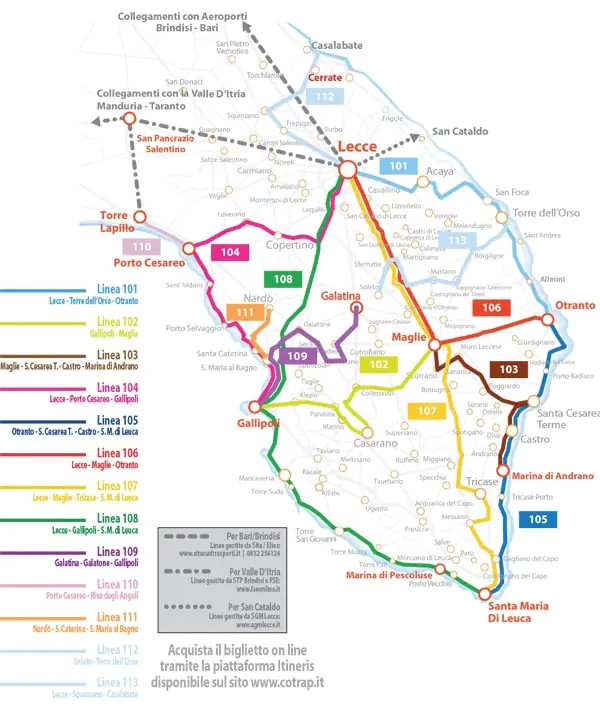
To visit Otranto, Maglie, Gallipoli and Tricase and places further north such as Nardo, Copertino and Galatina, even in summer we would still advise taking the FSE trains from and to Lecce main station. For places further south, the seasonal bus services are likely to be more convenient in the summer - if preferred these can be picked up at Maglie, Gallipoli or Otranto as well as Lecce. Likely to be of particular interest in the summer routes are:
Service 107 - Lecce/Maglie/Tricase/Santa Maria di Leuca - this is the direct route to the tip of Italy's "heel", in just over 2 hours
Service 108 - Lecce/Gallipoli/Torre San Giovanni - also to Santa Maria di Leuca, via the Ionian coastline
Sevice 105 - Otranto/Santa Ceserea Terme/Marina di Andrano/Santa Maria di Leuca - the best way to see and visit this southern part of the Adriatic coast
***
Cotrap (Consorzi Trasporti Aziendi Pugliesi) and how to use its online search facility
COTRAP is a consortium of bus and coach operators in Puglia which aims to encourage bus use. In particular it offers a common booking and enquiry facility on its website. In principle this seems a great idea. In practice it has significant limitations and is quite hard for the casual user to operate. Where possible, it is usually better to use the search facilities offered by individual bus operators;. However increasing numbers of operators are automatically linking anyone who makes timetable enquiries via their own websites straight through to the COTRAP website; in practice therefore it is often necessary to refer to it. .
The deficiencies of COTRAP are:
- the only routes offered are those operated by consortium members, which reduces or eliminates many travel options, even very obvious ones; in particular the bus services offered by FSE are not currently part of the Cotrap consortium - so if you look up a trip extending into Brindisi, Taranto and Lecce Provinces, the myriad of Ferrovia del Sud Est bus routes will not feature on COTRAP, and it is therefore vital to consult FSE bus options as well as COTRAP
- you are not shown a timetable for a service, route etc to get an overall picture of what is available; you have to specifiy a starting point, finish point, date and time; the starting and finishing points are specified in terms of communes (towns or districts) and stops within them which is awkward if you don't know the territory
- quite frequently the result is shown as not found or suggests you have filled in the wrong information; if you fill in alternative dates and/or times this obstacle disappears and you are presented with some options; also, because the options presented are "stop specific", you may need to try different arrival and/or departure stops to make sure you are not missing something
- when given, the timetable options are clear enough, but the route details are confusing, especially if changes are involved
When using the Cotrap website, so here are some suggestions which hopefully will help:
- this link takes you to the “book now” page; you can search for travel options here, and you can book tickets here if you want
- make sure you are using “linea extraurbana”, this is what you will normally need for visits between places
- you can specify you are looking for options with or without changes, and if the former whether you just want 1 change; check “yes” or “si”, and then check 2, so that all options will be considered whether or not they involve changes
- you can specificy which of the consortium members you wish to use, this is normally not necessary or helpful, so make sure the box says “all operators” or “tutte le aziende”
- fill in the departure and arival communes – you will usually get a drop down list here to select from after you fill in the first few letters; fill in departure option first, then arrival - note the website will only generate a drop down list of arrival communes served from the one you have specified as a departure
- as well as the commune, you have to enter a specific stop within the commune for departure and arrival, it is only possible to do this when you have filled in both departure and arrival communes; sometimes there is a single stop (“fermata”) which comes up, but more often a drop down list from which you select, in many cases indicating which is the “principal” stop, usually a good bet unless you know otherwise
- where there are several stops available, and you don’t know which one to use, you can open a map which shows where they are – this is a useful facility, especially as it indicates the name of the agency/company operating from each stop (note, if you open the map facility, you may need to press "escape" to come out of it and get back to your search)
- entering date and time is straightforward; then press “cerca corso” which means find the route (English translations may say “race search”, one of a number of translation ofddities thrown up by Google translate!)
- scroll down and all the options will be shown for the day in question starting from the time you have specified, so best to enter an early time; there is also an option of checking days before and after the one selected
- you can check out a return if you want easily by using the arrows to swap departure and arrival communes you specified, but you will have to re-enter the stops etc
- if your search does not yield results, try entering an earlier time, or a different day, or a different stop; this sometimes works
- you can add (“aggiungi”) your selected route if you want to buy a ticket online; do this if you want, but you can just note details and get a ticket at a bar or sales point near the departure point or on the bus.
If you are using the COTRAP search facility for bus routes in Brindisi, Taranto and Lecce provinces, it is vital that you also search for the FSE website, as important FSE bus options will not be shown via COTRAP.

